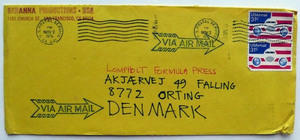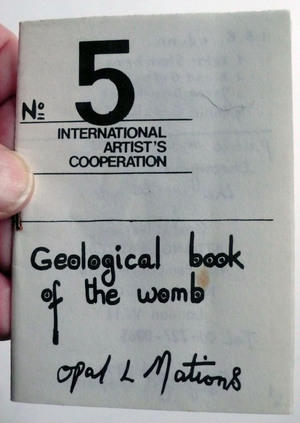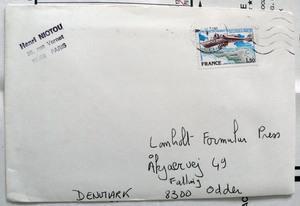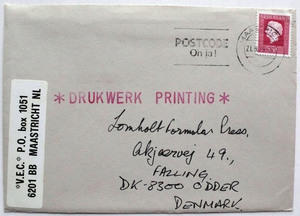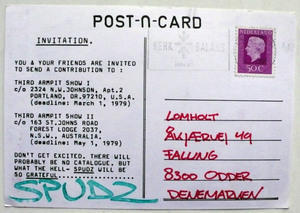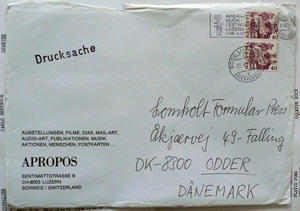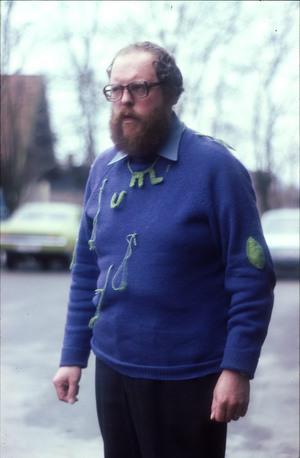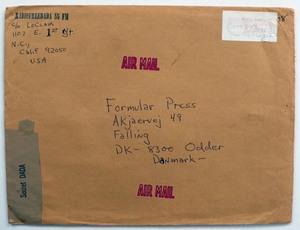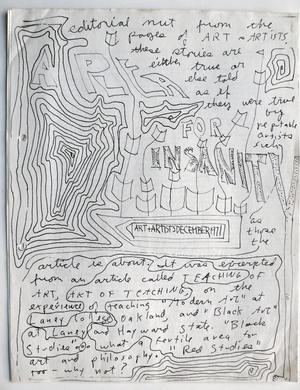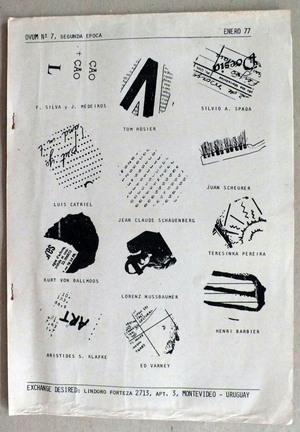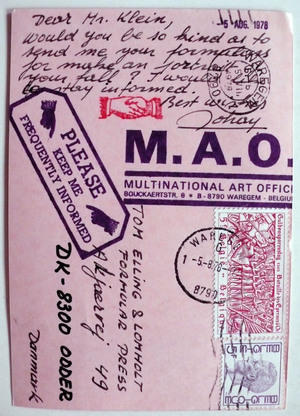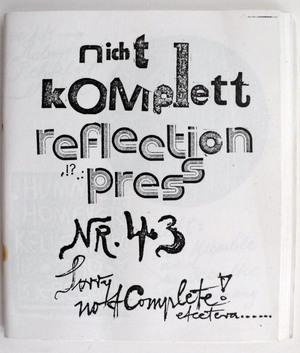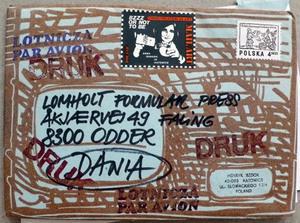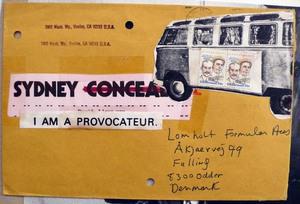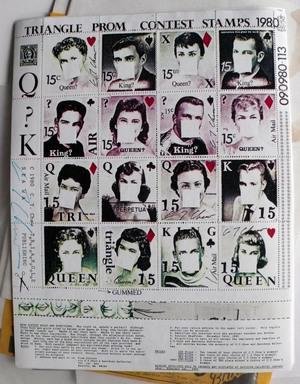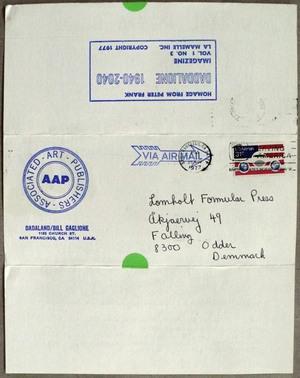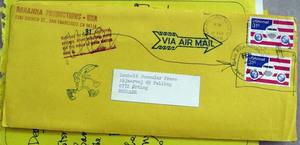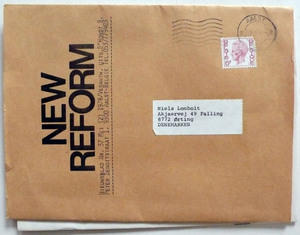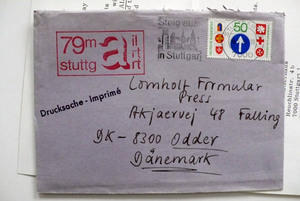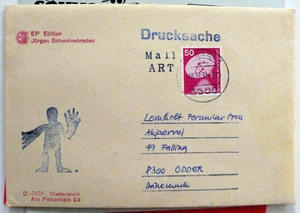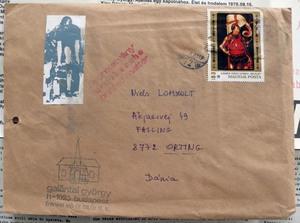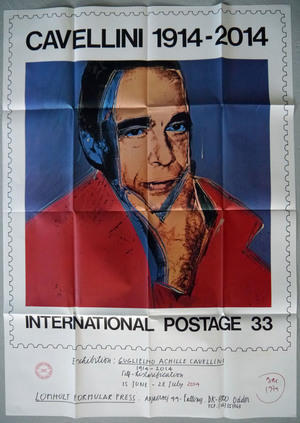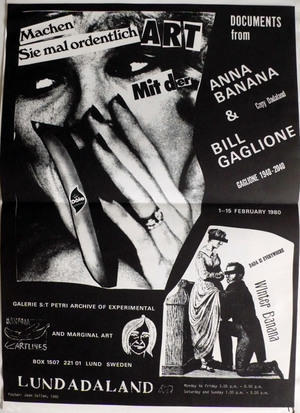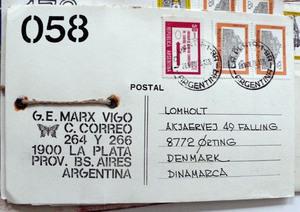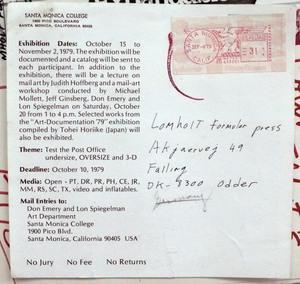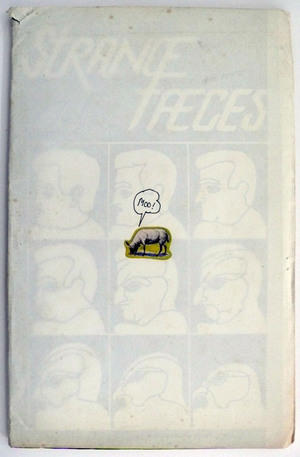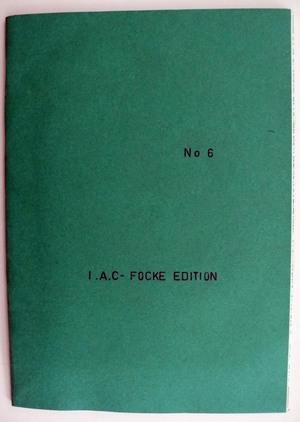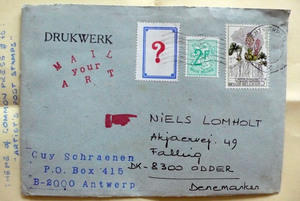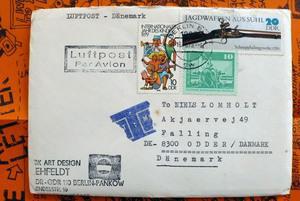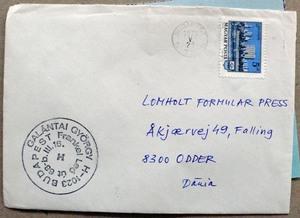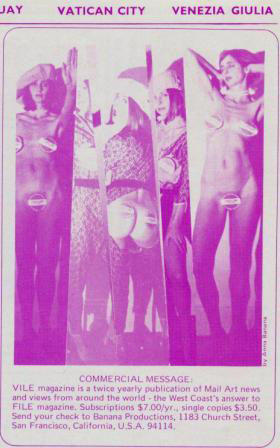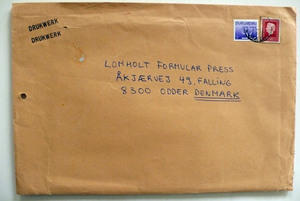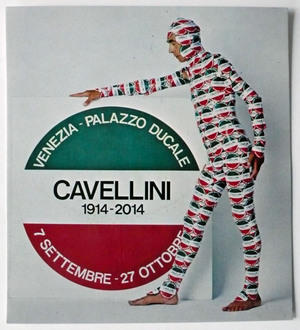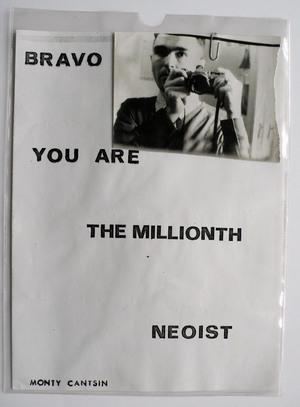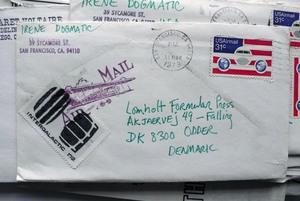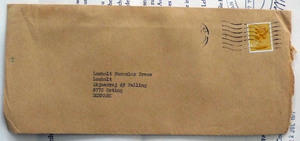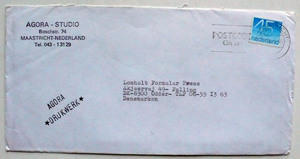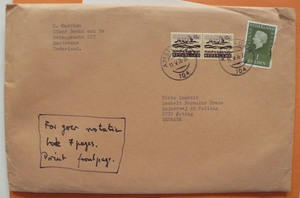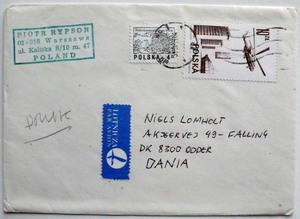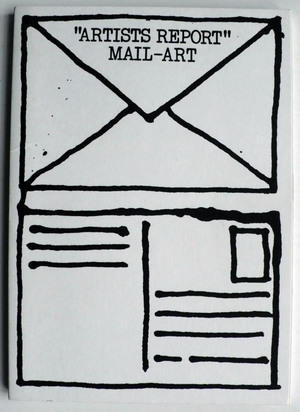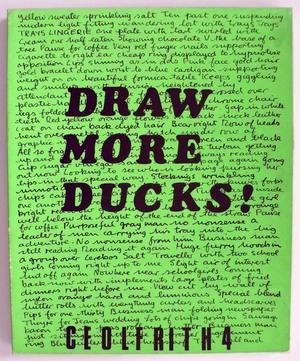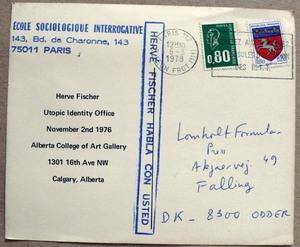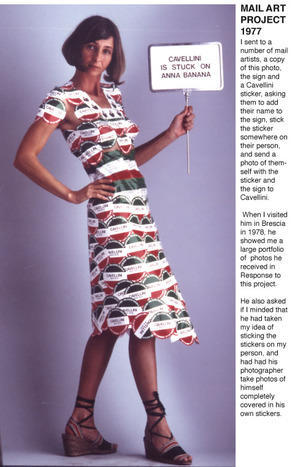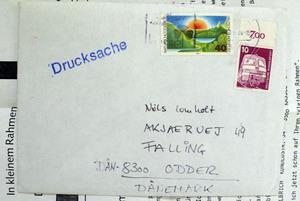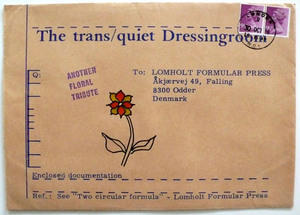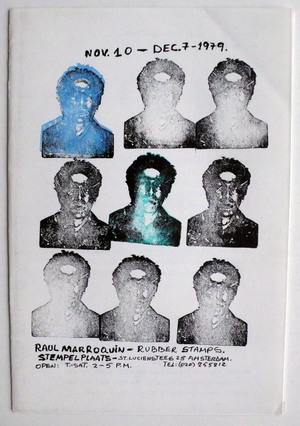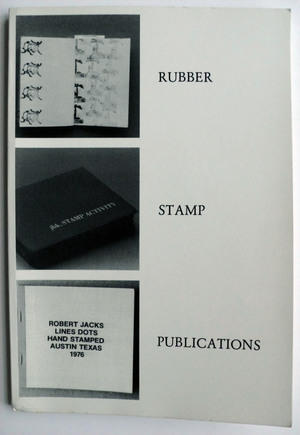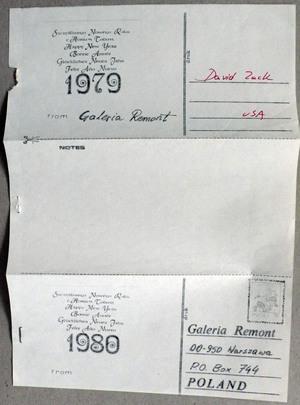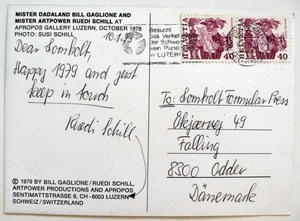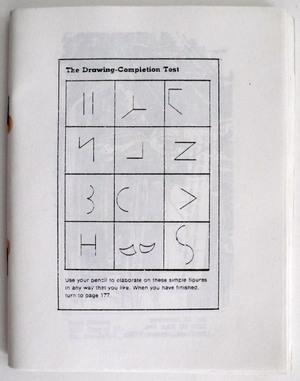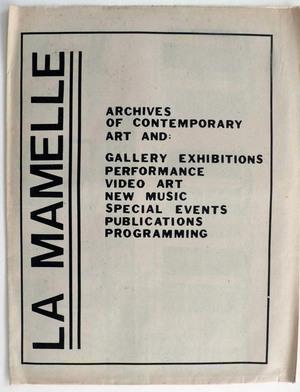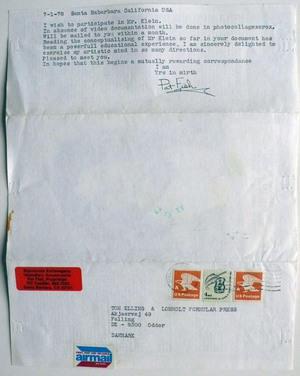Excerpts From a Mail Artist’s Diary
By Anna Banana
What Mail Art means to me, bottom line
Mail Art has been, for me, a way of connecting with like-minded, creative people who engage in and enjoy exchanging works on paper via the international postal systems. Persons who will respond to items received, including invitations to participate in individual projects, assembling books, or exhibitions on a particular theme. The Mail Art network operates on a gift economy, in which works are given or exchanged freely, with no thoughts of remuneration or reward, other than a response from recipients. In the instance of exhibitions, a catalog is accepted as fair exchange for works sent, for assembling projects, a copy of the finished book. The majority of items exchanged however, are not in response to such invitations, but are either visual or verbal artworks an individual wishes to share, or magazine or newspaper clippings relevant to the recipient.
Background
In 1971-2, I was living alone in a beach cabin without running water, having recently returned to Canada from 2 years at Esalen Institute in Big Sur, California. The cabin was half way between Sooke and Port Renfrew at the end of the West Coast Road. I supported myself by giving workshops in Esalen Massage in Vancouver, Ottawa and Toronto. Between workshops, I was creating batik wall hangings and lengths of fabric. I was isolated, and had no obvious way of connecting with people in the area. In spite of my article in Macleans’ Magazine, the batik work wasn’t selling, so I was looking for other ways to create and interact with people. I had taken to painting geometric designs on some large smooth, rounded rocks found on the beach, and came up with the idea of taking them into Victoria to sell as door stops or paper weights. I decided on Bastion Square, heart of tourist traffic in Victoria, but no sooner had I decided to pursue that idea, others suggested themselves.
Sitting at a table to sell painted rocks did not inspire, but using that public space to interact with passer-by; have them take up an item offered for inspection, or collect their banana jokes or stories, or have them sign a petition against nuclear testing at Amchitka . . . these offered more interesting opportunities for interaction. In the end, I visualized three card tables, and a chair and some signage . . . out of which considerations, emerged the idea of declaring myself the Town Fool!
To get this idea across, I prepared an announcement declaring myself Town Fool, sent them to the papers and radio stations, and set off to Bastion Square to see how it might work out. During my first day, I was approached by an angry shop keeper who told me I couldn’t stay there; that they pay taxes all year round, and here was I, trying to take sales from them without a license. I didn’t move, but the next time I arrived to set up, a man came out of one of the shops on the square, and told me that the merchants had a meeting, and decided to get rid of me by reporting me for selling without a license or collecting sales tax. He said he liked what I was doing and suggested I set up in front of his shop, that he’d put any sales I had through his till, collect the tax and give me the money. That got the bloodhounds off my back, and I spent several weeks there in August and September.
I’d begun publishing my newsletter, the Banana Rag to announce my activities, which had expanded to teaching paper mache technique to a group of seniors at the Silver Threads Society. The weather turned cold in October, and the tourists evaporated, so I began taking the newsletter to local schools offering to teach workshops in the lunch hour or after school. I set off alarm bells by not going through the school board, or the principals office, but handing out the newsletter to children in the school yard during recess and lunch hour. In this manner, I discovered a few schools willing to accept my offer, in spite of my unconventional approach and appearance which, by this time, was full on foolish.
I sent copies of the newsletter to a friend in Vancouver and got, in return, a copy of the Image Bank Request List. It was a listing of names, addresses and image requests from artists in contact with the Vancouver group Image Bank; Gary Lee Nova/Art Rat, Michael Morris/Marcel Dot, Vincent Trasov/Mr. Peanut.
The Fun Begins
Having no idea who these people were, or what might result from responding to their requests, I decided, none the less, to collect the requested images and mail them off and see what happened. I included copies of the Banana Rag, with a note saying I was interested in all things banana; images, photos, stories, jokes, songs, etc. Within a couple of weeks my mail box lit up; I was receiving notes and banana items from many of the persons I had sent images to. Thus, in the fall of 1971, began my 42 year practice of Mail Art exchanges.
The first Mail Artist I met in ‘71 was Ken Friedman, who was doing a residency/installation at the Vancouver Art Gallery. By way of introduction, he sent a single sock, one of his “Sock of the Month Club” mailing, then came to the Vancouver island to meet me. I was confused by his enthusiasm for a group called FLUXUS, which he claimed had started Mail Art. Others I met during my workshop stays in Vancouver and Toronto included the Image Bankers along with Glenn Lewis, Eric Metcalfe, Dana Atchley, Robert Fones/Candycane man and David Zack, with whom I’d been corresponding.
My year as Town Fool of Victoria had been an uphill climb, and I was tired of trying to explain myself and my activities to people whose idea of art was limited to objects hung on walls or sitting on plinths. I thought the best thing to do would be to travel around, meet many of the mail-artists I’d been exchanging with and from these meetings decide where I would live next; someplace that would be more supportive of my banana events and activities than Victoria. In the September ‘72 Banana Rag, I announced “Town Fool Quits,” left Sooke and Victoria, and took a sublet room at the New Era Residence in Vancouver, with then mail-artists Glenn Lewis, Eric Metcalfe and Kate Craig. During the next few months, I purchased a new Dodge van, and spent the winter building bed, cupboards and kitchen into it, modelled on the van Dana Atchley’s used for his Ace Space travels. I wrote to my correspondents along my travel route, alerting them to my upcoming visit, leaving Vancouver after my April Fool’s Day event, the “Mona Banana Smile Test”, at the Vancouver Art Gallery in April 1973.
In San Francisco I connected with Mail Art friends, Michael Rainbow, Bay Area Dadaists Bill Gaglione, Tim Mancusi, Charles Chickadel, and Monty Cazazza, as well as Opal Nations, Patricia Tavenner and Irene Dogmatic. I stayed for six weeks, putting out an edition of the Banana Rag, organizing a costumed visit to the Oakland Museum by a bunch of Bay Area Dadaists, and participated in the closing event of an exhibit at the Mostly Flowers Gallery, where a group of us handed out bananas to passers-by, took group photos, and “Mona Banana Smile Test” shots. Among the group of artists participating in this event were Ken Friedman and Futzie Nutzle.
While it was apparent that San Francisco would become my new home, I decided I should push on with my planned travels, having alerted correspondents in Los Angeles, Phoenix, Albuquerque, Tesuque, NM, and Gurdon, Ark. that I would be along in due course. In LA, I stayed with Lowell Darling and Co., (Fat City School of Finds Art) where Willoughby Sharp and Lisa Bear were visiting from New York. I didn’t meet any other LA correspondents at that time. In Phoenix, I stayed with mail-artist Linda McCool, then headed for Susan at Educational Projectiles and Ron & Louise, at the Non-Phenomena Foundation in Albuquerque where I got to stay in a home of a traveling friend. After a few days of sight-seeing, I traveled on to Tesuque, NM staying with Mail Artist Warren Davis/Sphinx West and family for a few days.
By this time, I had come to realize that driving long distances alone was not a lot of fun, nor was parking overnight in campgrounds of noisy groups or off the highway on side roads. Looking again at the maps I saw it was an even longer haul from Tesuque NM to Gurdon ARK, where I was to visit BuzBlurr/Russel L. Butler; with no friends to visit in between. I already knew I would go back to San Francisco to live, so instead of heading south east, I went north west to Crested Butte, Colorado, to visit with Dana Atchley. From there, I made a call to San Francisco to see if I had a place to stay until I found a place of my own. I got a green light, so proceeded back to San Francisco.
San Francisco, Bay Area DADA & Bananology Mix
I felt like I’d died and gone to heaven. Here I was in the middle of a group of artists who were all doing mail-art, little publications, and dadaesque public events such as the annual April Fool’s Day group portrait at the Cable Car barn, or the “pink dot” campaign.
At the center of this activity, were Gaglione, Mancusi and Chickadel, aka Trinity Press, who also edited and published the New York Correspondence School Weekly Breeder. Ken Friedman founded the Weekly Breeder in 1971 as a one-page weekly periodical equally inspired by the graduate school publication, My Weekly Reader, and by Ray Johnson's New York Correspondence School mailings. After 11 or 12 issues, Friedman passed the editorship on to Stuart Horn, another friend of Ray Johnson. Horn, in turn, handed it over to Mancusi, of the Bay Area Dadaists, in whose hands it prospered and flourished for several years.
The incoming mail was full of a whole series of little zines; pages one quarter of an 28 x 21,5 cm sheet, reproduced using photo copy or instant printing, (paper plates rather than metal ones), and stapled in the middle.
As well as calling themselves the Bay Area Dadaists (BAD), the group intended to publish their zines under the imprint Trinity Press, after Chickadel purchased an old AB Dick printing press. They were going to use it to publish issues of the Weekly Breeder, which was an early version of Common Press in the 1980s, in which editorship was undertaken by various mail-artists. Friedman’s issues were a single sheet, such as the one that accompanied a single sock; his “sock of the Month Club,” a pun/parody on the commercial Book of the Month Club. While they never used their press for the Breeder, the BAD did produce six issues of the Breeder under the persistent guidance of Mancusi, growing from a two page, 28 x 21,5 cm zine, largely of the group’s collages, to their final issue in 1974 of about 20 pages.
As Mancusi stated, “I always thought the six issues of the Weekly Breeder that I published from May 1972 until the Fall of 1974 were instrumental in defining what zines of that period looked like. There was a definite difference from the look of the photocopied zine that was less expensive to run off at the time, since there was no ink involved, and photocopying was more accessible. Produced in editions of 200, these zines were exchanged with network artists who, in turn sent their zines and collages.”
In ‘73, this activity spawned a series of little zines, in the format 1/4 of the standard 28 x 21,5 cm sheet, i.e. 14 x 10,7 cm; West Bay Dadaist, credited to Authur Cravan, Editor, Foundling Publications, Trinity Press, SF. The issue includes news paper clippings of bizarre stories; “Jesus did not have long hair,” “Flag on Pants/Sentence Upheld,” “Cardboard Cows Crowd Above the Freeways,” and clips from comic strips.
In '74, Chickadel (Carlo Cicatelli) started QUOZ? calling it Vol. 11 No. 8, Dec. '74, while the cover reads FLUSH ART, over a photo of Ken Friedman congratulating Tim Mancusi on his “Very Last Weekly Breeder.” Chickadel produced several other of small format zines such as Quoz? Vol. III No. 11 1975, Flush Art, Vol. 11 No. 8, Dec. 1974, West Bay Dadaist, Vol. 1 No. 1, May 1973, and Vol. 1 No. 2, June ‘73, using his nom de plume, Arthur Craven, Trinity Press. Also, Flush Art, Vol. 11 No. 8, Dec. 1974. All these publications were iconoclastic/DADA in orientation, sometimes with political overtones.
One of the many other 14 x 10,7 cm zines I received during that period is the 1973 Dogarithms, 16 pages of puns on song lyrics, by Irene Dogmatic, a dog lover and serious painter in her “other life.” Dogarithms was dedicated to Opal L. Nations, a specialist in DooWop music with a half hour weekly program on KPFA, listener sponsored radio. Dogarithms presents a series of puns on songs, with dogs inserted in the titles such as “I Left my Dog in San Francisco,” “I Wanna hold your Dog,” “Someday my Dog will Come.” The titles are rubber stamped on each page, and each song is illustrated in Dogmatic’s inimitable sketchy style.
Strange Faeces is by British artist Opal L. Nations, who landed in San Francisco around 1972, staying a few years, before moving to Boston, then someplace in Vermont, and eventually returning to the Bay Area in the 90’s. He and I worked together at Speed Print, on the California on the Graphic Arts Directory for a short time; a project that was eventually abandoned by the proprietor. Opal was well know prior to his arrival, for his publication Strange Faeces, a large format zine (35,5 x 22 cm) of his drawings and collages, which are well described by the title. Opal participated in various BAD activities, including a costumed visit I organized, to the Oakland Museum, April Fool’s Day group portraits and shows at the Mostly Flowers Gallery. Other of his publications include International Artist’s Cooperation, No. 5 1973, Opal L. Nations. London, and Cricket ‘84, ©’73, Opal L. Nations, San Francisco.
Patricia Tavenner (deceased in 2013) with her partner Lou Carson began publishing Mail Order Art in a newspaper/print format in 1971.
British Artist Genesis P. Orridge was active at this time, producing Copyright Breeches under his Mail Art name COUM, which was printed at Beau Geste Press 1972-3. While I didn’t meet him until 1978, during the Futurist Sound tour, he and his then partner Cosy Fanni Tutti came to California, and stayed with Monty Cazazza, where they produced a series of sexist photos later published in an issue of VILE magazine. Genesis and Cosy performed as the band Throbbing Gristle, and did performances in England and Europe. One of their Mail Art themes was “Global Infantalism,” symbolized by a baby pacifier.
Obviously, there were many artists that I haven’t met in person, producing zines and other publications. A sampling of the small 14 x 10,7 cm format, includes: 491, Vol. 1 #1 Portrait of File Mag. Tom Hoiser; ? @4711 Waldrop A3; Forest Park, GA, 1973 and 491, Vol. 1 #3, 1973; Montage Drawings by Priscilla Birge, 1973; Modern Correspondence mag. #1, Clandestine Comic co., Tom Hoiser, PO Box 253, Plymouth, CT.- 1974; Mix Magazine, June/July ’73, Ron Shuebrook & Terry Sladden, Saskatoon; Instrmentos/74/OVUM, Clemente Padin, Uruguay; Changing Personalities, ‘74, Marroquin & Verhoeven/MAD Enterprises, Maastricht; The Score, ‘74, Al Blaster/Dr. Ackerman.
There are many other larger format publications from the 70’s, most of which were published in the standard 28 x 21,5 , 21,5 x 14 cm, or A-4 formats, including my own VILE magazine. FILE, first published in 1972 by the General Idea group George Zontel/Horhay, Felix Partz and A.A. Bronson/aka Michael Timms in Toronto, featured Vancouver artist Mr. Peanut/Vincent Trasov, on the cover. FILE amongst it’s other editorial features, took over the function of the Image Bank Request lists, publishing the names and addresses of artists active in mail-art networking for several years. Initially FILE focused on Canadian art scene (connected initially by, but not mail-art per se) in Vancouver and Toronto, but quickly expanded it’s coverage to the wider network. It was the same size, (34,2 x 26,6 cm) as LIFE magazine, which it parodied, and was, as mentioned elsewhere, the inspiration for VILE. They published 6-8 issues before LIFE magazine got on their case, and they had to change the cover/logo, at which time, they also changed their focus to the more “hip” New York scene.
The list of contributors to these zines reads like a who’s who of Mail Art during the early seventies. For the most part, these publications with their “up yours” attitudes, are crudely made and reproduced, and are probably the inspiration for Hudson of Ant Farm’s damming comment about “quikkopy krap,” in the September ‘73 Vol. 2 # 3 of FILE Magazine. You couldn’t possibly have screened any of the people you give boosts to (Tom Marioni? limp wimp of the West Coast art scene/ Dakota Junk Co? Trash nothings at best/Dadaland? Ineffectual student art groupies), because I’m sure you’re more perceptive than all that. The correspondence scene has gotten out of hand - every day I have to reject 2nd rate junk Mail Art that asks you to send to their shows.”
In the same issue, Robert Cummings writes; “I get stuff every day that makes it barely out of the envelope and into the trash it’s so terrible. Its not the terribleness of the art that worries me, but the enormous waste of paper. I can no longer answer a bad piece of mail with a letter or photo. I used to answer everything I got, but now find myself ignoring 3/4 of it out of principle and lack of energy. There’s too much of it.”
Maybe those guys were just pushing buttons, trying to get a rise, but whatever their intent, their comments inspired me to create VILE magazine, a parody of FILE, itself a parody of LIFE magazine. From my perspective, Mail Art networking was the best thing happening in art at the time, and I was determined honor and document network activity. I got right at it, put out a call to my correspondents, and was soon flooded with material. What I had in mind to was to create pages using LIFE magazine’s format of photos and ads with copy wrapped around and between. However networkers sent full page artworks, so rather than wait for material I could work into the LIFE-like format I had in mind, I went ahead and published VILE 1 in time to present it at Decca Dance, the network event in Hollywood in February 1974.
A weekend network event in 1974, the Decca Dance was a collaboration by Image Bank in Vancouver, General Idea in Toronto, and Lowell Darling/Fat City School of Finds Art in Los Angeles, and drew artists from those cities as well as New York (John Dowd) and San Francisco (myself, Gaglione, Opal & Ellen Nations, Irene Dogmatic). It was a weekend of performances, events, costumes, drinking and late nights, and in a way, marked the end of an era in which Mail Art and more “hip,” mainstream art parted company.
From Vol. 1 No. 1 in April ‘72 through the following 6 editions, FILE ran both the Artists’ Request lists and an Artist Directory; several issues after the negative comments by Hudson and Cummings were published. Both the Request Lists and Artist Directories were peopled by artists actively networking by mail, which indicates to me that FILE’s audience through Vol. 3 No. 2 Spring ‘76, was largely comprised of artists engaged in mailed exchanges. I believe it was the influence of FILE that grew the network at an exponential rate, perhaps part of the “too much” problem. From Vol. 3 No. 3, Spring 1977 on, FILE moved into covering the more mainstream art and music scenes with their New York issue. By then, most of us had our own mailing lists well established, and with the ongoing publication of both the Banana Rag and VILE magazine, the problem was more how to keep up with it all, than how to make more contacts.
From January ‘74 through Dec. ‘80, I produced seven issues of VILE, with Gaglione in the editor’s seat for the 4th, 6th and 7th, in each case, changing the look and format, with his last being an assembling of rubber stamp works in a limited edition of 200, which meant a total departure from my original concept of VILE content and format.
My involvement in the Mail Art network has always extended beyond mail exchanges of artworks, to in-person visits, performances and events, as first witnessed in my visits to Mail Artists while deciding where to live after my Town fool Project in Victoria, BC. For the 1975 Banana Olympics event I staged in San Francisco, Mail Artists Klaus Groh from Germany, Marek Konieczny from Poland, and Kenneth Smith from Canada came as judges of the contests. Unfortunately, Konieczny misunderstood the bus schedule from NYC, arriving in San Francisco at 10 pm, Sunday March 30, 5 hours after the Banana Olympics were over!
I received several proxy entries in the races, sent by Mail Artists, a great many artworks on the theme, including a giant paper mache banana signed by a group in Germany. Drawings and graphics came from network artists Antonio Luiz Morais De Andrade, Brazil; Horst Tress from Cologne, Germany; Peter Van Beveren, Netherlands; and Clemente Padin from Uruguay. Mail Artist Benson Shaw from Albuquerque, NM entered his giant-wheeled sculpture in the Non-Motorized Vehicles race, wearing his black, Darth Vadar-like helmet and pontoon-like shoes.
Suggestions for events came from Michael Scott, Leeds, England; Spaceangel, Portland, OR; Richard Morris, COSMEP, SF, Marsh, Billings Montana; Al Blaster Ackerman, Houston, TX; Gary G. Miller, Trenton, MI; Haddock, Waco TX; Jim Bohn, Crescent Moon Novelties; and David Highsmith, Lansing, MI. The entire event was produced and staffed by volunteers, and publicized with a full-page ad in the SF Bay Guardian, where I was working at the time. Over 100 locals participated in the goofy races, and another 12 performed in the Banana Music contest that was part of the afternoon’s event. Banana Rag No. 11, May ’75 http://mypage.uniserve.ca/~a_banana/rag.html was devoted to photos and other coverage of the event.
My 1978 European performance tour of the Banana Olympics film, slides and Italian Futurist Sintesi, with Bill Gaglione, was arranged entirely through my Mail Art contacts. I had no other connections in Europe at that time.
Before we left San Francisco – I had sixteen dates confirmed and our travel schedule outlined for the three and half months of our stay. After we began touring, an additional twelve dates were arranged; six through Mail Art friends, the others through friends of the galleries where we had performed. Initially we had no plan to go to Sweden, but a paying invitation came from Sweden, while our Italian contact (Vittore Baroni) gave no indication of being able to arrange anything until we were in Parma, by which time the dates in Sweden had been confirmed.
Our first stop – Was in London, where Pauline Smith (Adolph Hitler Fan Club) put us up in her flat. Bernard Kelly (London Dada Services) arranged for us to perform at meeting of his DADA group at the Enterprise Pub. From the way its members interacted with our performance, I concluded that they had an equivalent attitude / approach to that of the Bay Area Dadaists, with references to Marinetti, and the futurist movement of Italy. Prior to our visit, I had corresponded with Kelly, James Haliday, Pauline Smith, Genesis P. Orridge in London, and Paul Carter who came from East Leigh, and Henri Niotou who came over from Paris for our show. During that time in London, we had a chance to meet with my other correspondent, Genesis P. Orridge. While this was the first performance of our tour, it was probably the most DADA event I’ve ever experienced. There were interjections from the “horn man” who blew his horn and jumped up yelling about “decadent bourgeois trash, and how he wasn’t going to sit there and listen to any more of it.” There was other heckling and performances by others in the group, including a “musical interlude,” as dada as all their other entrees.
Our next stop – Was Waregem, where Johan van Geluwe put us up, showed us his amazing collection of rubber stamps, telling us his approach to Mail Art is to rubber stamp everything he receives, then mail it on. He has a vast collection of rubber stamps (over 500); his own designs, ready-mades and official Waregem and some original Nazi stamps. In spite of sending everything on, his studio was piled high with publications and papers. He began mailing in 1971, having been introduced to the network by Peter Van Beveren. Prior to that van Geluwe did not paint, sculpt or do any of the more traditional art forms.
The day after our arrival – We went to de Hoop Pub to set up for the show on a very tiny stage in a fairly small pub. Our performance that night went off without a hitch, to the complete bewilderment of the pub’s clientele. The place was totally silent for several minutes after the performance, then gradually people came up and asked for Degrees of Bananology.
The next day – We travelled to Aalst, to meet Roger D’Hondt, who took us to Brussels to give us a preview of the Beursschouwburg Theatre where we would perform October 8 as part of a big performance festival. After that, we took the train to Antwerp for our next performance at the ICC, a former palacial home of Napoleon and two kings in following centuries! The event previous to ours (to give an idea of the setting and general fare of the place) was a chamber orchestra performing for the Queen of Belgium! We were hosted there by Guy & Anne Schraenen, and the audience for our performance consisted of them, the director Fleuri, Glenn and lady friend, Jean-Paul and three or four other staff, a woman with long red hair, an old couple of 75+ years who were alarmed by our performance and thought us crazy! That was all the audience, in a hall large enough to seat 150.
In Maastricht the next day – We met Theo Van der Aa, of Agora Studio who, along with Rod Summers and Raul Marroquin, had been publishing, since the early ‘70’s, some of my work in their large format periodical Fandangos. Theo put us up in a hotel and fed us a fabulous dinner in his home, prepared by his partner Ghere. The next day, we moved to Agora Studio, where we met Rod and Elizabeth Summers. There, we did some limited edition prints using a large stamp pad and the soles of our shoes. Rod did a recording of “the sound of a banana being eaten,” which was pretty subtle. I’d had many exchanges with this group that published our works in Fandangos. Rod’s current VEC/Visual Entertainment Company environmental project, was photographing and making sound recordings in 3 locations around Maastricht, over a 24 hour period; to be repeated in 25 years and installed in the historical museum of Maastricht.
Next stop – Cologne, where Wulle Konsumkunst took us to an experimental music concert by Albrecht d who was accompanied, amongst others by another of our correspondents, Angelika Schmidt. This took place in the Beginners Studios with Walter Zimmermann recording. On Saturday Sept. 23, Wulle took us to the Baack’scher Kunstraum to set up our props and slides. With Wulle and Anlita Baack, director, we met Hans Holm, another of my Mail Art correspondents. The next day, after the performance, Wulle gave us a walking tour of Cologne, showed slide documentation from the 100 Day Art Festival in Ubbeboda, Sweden, and from a presentation of Adam & Eve at the New Reform Gallery in Aalst. We also spent time looking at Wulle’s Limited Edition xeroxed books, and discovered Gebhard Eirich, with whom I had corresponded two years earlier, is one and the same person as Wulle.
We had a ten day break in Amsterdam next – Staying in Michael Gibb’s apartment, which gave us a little time to catch our breath, and meet some of our correspondents there. First stop was with Ulisses Carrion at Other books and So. He was as warm and personable as all the reports we’d heard, and the bookstore the mind boggler reported. While Bill immediately put his nose into some books, Ulisses chastised him for not spending some time speaking with him! After this visit, we went to see Aart van Barneveld at Stempelplaats to deliver our rubber-stamp works and catalogue for our show there in November. Aart had a great job organizing rubber stamp shows and doing a catalog for each, at the expense of the big rubber stamp manufacturing firm in whose building the gallery was housed. In the basement is a rubber stamp workshop and a museum of old stamps.
We also visited Video Heads for a showing of Raul Marroquin’s newest tape. While they told us to come at 7:30, we didn’t get there until 8:30, and Raul’s tape didn’t go on until 9:30. In the meantime, three monitors were going, including a large fashion show extravaganza, cut with Bambi and Charlie Chaplin’s Modern Times. The environment was very comfortable, floor lined with 6 inch foam, covered with black corduroy plus inclining slabs to rest against. The sound track on Raul’s tape, recorded separately from the video, was not always clear, which made the acting look worse than it was. People weren’t actually speaking their lines so it didn’t look like they were saying what we were hearing, and often there was no sound when their lips were moving, or vice versa. The acted part was cut with scenes from an old Western, stationery art work and hand written notes announcing scene changes or plot progressions and color commercials from American TV!
September 29 – Our performance at Other Books and So was packed and well received. We kept busy the 10 days we had in Amsterdam, visiting, designing stamps for a book Aart was doing, and me doing a lot of correspondence arranging further performance dates.
October 5 – We took the train to Rotterdam, and eventually found Cees Francke by having him paged. He took us to the Verster Gallery to meet Mr. Oosterhoff, the director, and see the space where we were to perform. It was bigger than most of the smaller galleries we’d done, and up on the fourth floor. We spent the evening at Cees’, making collaborative postcards and looking at the many books he’s made. His first Armpit Mail Art show, in which I had participated, was on the walls in large plastic display pages.
Next day – We set-up the gallery, then visited a retrospective show of Max Klinger, then spent an hour in a 2nd hand bookstore. That evening there was an opening on the 2nd and 3rd floors of the Verster, with liquor flowing, so lots of people came upstairs for our show. We lost 10 or 15 during the Bananology documentation, but still had 65 or 70 for our Futurist Sound performance. Gave out lots of degrees of Bananology, then out for drinks where we met another of my correspondents, Woody van Amen.
October 7 - We took the train to Brussels, and went straight to Theatre Beursschouwburg, to drop off our props and get things organized for the evening performance. On the way to our hotel, we took the subway, to see a performance in a subway tunnel; lights, clown white faces, lady up on a ladder waving. The whole thing set up like a camp with maybe a dozen performers, lots of colored spotlights. Our show was at 9 pm, and the balcony of the theatre was closed for projection equipment and video cameras, but downstairs was mostly filled; 150-200 people. Our projections went well using automatic timers on slides, with the film finishing maybe 2 minutes before the slides, while I did a commentary using a microphone.
We got laughs from the audience even though the majority of Belgians don’t speak English (at least not in ‘78). Bill’s two DADA pieces were well received, then into the Futurist material that got laughs, cat-calls and assorted ridiculous responses. We loved it. First time we had an audience large and removed enough for them to be spontaneous in their responses. The intimate situations are good, but don’t give enough distance or anonymity for that sort of reaction, unless you’re part of the London Dada Services.
The next day – Buky Ginsberg picked us up from our hotel and drove us to Amsterdam. There we got a train to Groningen, with a transfer to Oldenberg for a dinner with Klaus Groh and friends. Unbenounced to us (not understanding announcements in Dutch or German) the train split, and one half goes to Groningen, the other to Leeuwarden in north west Holland. Because we were traveling on Euro rail Passes, we had no stubs indicating our destination, so were not notified of the split. When we arrived in Leeuwarden, through the mercy of a man in the station, we got a call through to Klaus, to explain our situation. Next we bussed to Leer on the border, then got a train to Oldenburg, where Klaus met us at 11 pm, 4 hours later than scheduled.
Monday October 9 – Next day, Klaus took us to visit Mr. Nieman at the State Theatre regarding our doing the show there. Klaus had already proposed it, and this meeting was to negotiate the details. We were introduced to Mr. Poleti who took us briskly downstairs to his office to get details for the program. Translating the titles of Futurist works into German was quite amusing, but the Bananology was downright funny. Poleti spoke very little English, so it was like a tennis game between him, Klaus and us. With all that arranged, we moved from Oldenberg to Berlin, with stop in Hannover. We got the first stamps in our passports going through East Germany.
Wednesday October 11 – Mike Steiner met us at the station in Berlin and drove us by the gallery so we could see the space; very small, mostly used for video productions. We stayed in a hotel, so never did see where Steiner lived, and I can’t recall exchanging Mail Art with him, so don’t know how this date got set up. Since the performance area was so small, we set up a display of photos, invites, reviews in the two front rooms, along with a monitor for spectators who couldn’t fit into the performance space. Lil Picard came and although in her 80’s she’s into the New York Correspondence scene and knows Ray Johnson, Ed Higgins, Fletcher Copp, etc. She commented on the photo of the star cut I did on Buster Cleveland’s head as an homage to Duchamp, and one of many cuts I’ve done. She said she likes to cut hair, then do a portrait of the individual using their hair to make the hair in the portrait.
In the very small space, our movements were very restricted, thus our performance was not our best. We were also conscious of the video camera and a not wildly enthusiastic response from our audience, which didn’t help either.
I had to phone Jürgen Schweinenbraden about our show in East Berlin the following night, but the phone in the bar didn’t GO to East Berlin, so I had to go around the corner to another phone. With the noise of the bar, and his limited English, my non existent German, it was a tough conversation. However, we managed to arrange to meet at the taxi stand outside the East Berlin station at 4:00.
October 13 – Going through to East Berlin customs was an exercise in patience, standing in a big room full of people waiting to have our number called, to pick up our passports. Luckily we were able to get some German/English speakers to listen for our numbers, otherwise we’d have gone nowhere. We found out later that the West German newspaper Bill had in his bag would have got us into a lot of trouble, probably they wouldn’t have let us go through, but they didn’t go through our bags.
When we got through, Jürgen met us and off we went in a tram. The differences between East & West Berlin were immediately apparent; East. being very drab, with few shops apparent, few cars, while West Berlin was a highly polished showplace of Western consumerism. Jürgen’s gallery was totally underground/not official; a big room above their flat, with no signage or any sort. The gallery, a large room, white walls, sisal carpet, a grand piano and paintings on the wall was an incredible contrast to the drab exterior of the building. Jürgen didn’t want us to hang any printed matter or show any publications . . . “just in case.” He also asked Bill to use some other newspaper than the one he brought from West Berlin, “just in case anyone infiltrates our meeting,” they would be in serious trouble.
Robert and Ruth Rehfeldt, our earliest mail-art connection in the Eastern block, arrived, and we talked and took photos. I tried to call Warszawa to say what time we would arrive, and hopefully, be met at the station, but got no answer.
Our performance was different than usual, with Irene, Jürgen’s partner, doing simultaneous translations of my remarks on Bananology. The slide projections went slowly, as there was only one tray for 36 slides, and I usually used 2 trays of 80, so I didn’t attempt to show them all, but the response was excellent. The room was packed with people who stayed for everything, 50 at least. They were interested and responsive like nothing else we’d experienced. Afterwards I was surrounded by people wanting Degrees. Through this, I learned that Rolf Staeck (another correspondent) attended, but didn’t stay to talk. There wasn’t much time for that anyway, as we had to get back to the border before midnight, and I wanted to make a few more attempts to contact the people in Warszawa.
Saturday October 14 – In Warszawa, we were met at the train by Piotr Rypson and Wieslaw Szweryn who took us to our hotel, a 30-story, modern wonder; 50’s kitchen with cracking walls and dripping plumbing. The performance was to be in Gallery Remont, which we later learned is a joke; REMONT is a sign you see all over Poland which means “closed.” It was part of the student union of the University of Warszawa. The next day Piotr took me to the gallery, but the student bridge club was occupying it, so we went for talk and tea. His English was perfect and, as being the son of two doctors, he had traveled a lot outside Poland. When we finally got in, we were going to put up a lot of our documentation, but the display board was so small, and there was a scarcity of such everyday items as thumb-tacks, so we showed only photos and two copies of VILE.
We were to start at 5 pm, but then the technical problems began. Electricity was blown by the video camera, brought in just to provide a closed circuit monitor for the window, as they couldn’t get tape! After that was fixed, the sound system went out. Eventually we started without it, with Anya reading a translation of my introduction to Bananology. Then I showed my slides with a very slow commentary, because of the translator’s lack of fluidity in Polish, and much heckling of him! They liked Bill’s DADA pieces, and I was mobbed at the end for Degrees.
October 16 – The next night, we meet at Gallery Remont to show slides of events and Mail Art, and discuss it all with the assembled students. Marek Konieczny (who came to San Francisco for the ‘75 Banana Olympics) was there, as was Miroslav Klivar. He came from Prague, Czechoslovakia to see us, since it was impossible for him to arrange for us to do anything there. These are all people with whom I exchanged Mail Art over the past six or seven years.
October 17 – We have a long wait for Wieslaw, who was getting our train tickets to Krakow. After much difficulty, pulling strings, and using the American money we gave him, he arrived with our tickets. We went for a walk in the old town, lost track of time, then end up running for blocks to get to the car to go to the station. We made it JUST in time to get on the train. We were drenched from running so far, and found the train packed so it was a long time before we could find seats.
My correspondent Stanislaw Urbansky met us at the station in Krakow, and took us to the home of Barbara Zambrzycka-Sliwa, where we were put up very comfortably on a hide-away bed in her living room. Stanislaw’s spoken English was very limited, and Barbara’s almost non existent, but we managed to communicate pretty well in spite of that. Barbara is an artist supported by the Polish government, and had such conveniences in her home as a washer, dryer, hair dryer and a TV. At breakfast, she put out so much food until there was no more room on the table! After that, we were off to the Forum Club to drop off our props, film, slides, etc., then went for a walking tour of Old Krakow, one of the few Polish towns that was not leveled in the war. We saw the theological college where the “new/then” pope came from, all draped with Vatican flags.
October 18 – Our performance was in the Forum Club, home of a famous Polish drama school. The whole building was an artist club, with bars and dining rooms upstairs, and downstairs the performance space; a small theatre with seating for 100 that slants down from the projection booth to a small stage. The turn out was small, perhaps 15-20, and a lot of what was said fell on deaf ears, for want of translation. I was very frustrated at my inability to communicate better. After the performance the audience got into a lengthy discussion about the seriousness of Bananology, but since it had to pass through a translator who spoke little English, we had no idea what they were saying about it all.
October 19 – I had wanted to get a train schedule earlier that day, and send a telegram to Henryk Bzdok about our arrival time in Katowice, but Stanislaw either didn’t understand or thought it unnecessary, so it didn’t get done. We found out later that Stanislaw had sent a telegram to Bzdok saying what day we’d arrive, but no arrival time, and he didn’t tell us he’d done so, so we didn’t look for or wait for Henryk when we arrived in Katowice! On the train we met an English speaker, who tried to convince us we should stay in a hotel, even though Henryk had written that we should stay with him. So when we got off, we headed off with this man, neglecting to look for Henryk, and proceeded right to his home, only 3 blocks from the station. That’s when we found out Stanislaw HAD sent a telegram, and Henryk’s wife Julie went off to find him while we played peek-a-boo with their children.
Henryk’s home turned out to be a large flat, with a little guest room, his studio, kitchen, bathroom and living room, so they were able to accommodate us, and were very happy to do so. It turned out Henryk had scheduled our show for the next evening at 5:00, and our train tickets to Budapest were for 5:40! Panic and hair tearing ensured, with not much language to discuss it. He was begging us to stay to help him “save face’! His friend Michael, who speaks English was coming soon, in the meanwhile, we said we’d stay and do the show if our transportation could be rearranged. Later, we realized we could have used those tickets that night after our show, as 5:40 was the time the train departed from Warszawa, and didn’t get to Katowice until 11:00 pm. Trying to arrange travel times was unimaginably difficult. In order to phone Budapest, a call had to go in to Warszawa, which would schedule and route the call from Katowice to Budapest! No direct dialing, that’s for sure.
We performed in the Artists’ Club of Katowice, in a room that seats 50, with nice stage area, lighting, etc. There was no super 8 film projector, and the slide projector hassled every slide, mangled one, lost another somewhere in its interior. We had a small audience, maybe 15-18, and again, the feeling of not connecting. We tried offering Degrees, but no takers. Discussion questions came out slowly, nothing provocative, but at least they came out of their silence.
October 21 – The next day, Henryk took us to see his huge wall mosaics at the university. A commission that made it possible for him to buy a cabin in the country. Three beautiful murals the length of the building inside, down one side of a hall (on all 3 floors) and outside a giant vertical one from ground to top of the 3rd floor. . . not socialist realism, but more contemporary impressionist. We also got to see the 30th annual show from the local art school; posters, graphics and book design of excellent quality, while the painting and sculpture interested me little.
That night, we attended a dinner party at their friend’s house, starting about 8 pm, walking so Henryk could drink; apparently the laws are very strict on this issue. It was in the head of the Art School’s large, old flat with high ceilinged rooms and beautiful furnishings. The meal was enormous with many courses, starting with jellied chicken salad, cold cuts, cheese and of course, vodka. That was followed by stewed ham hocks (one per person!), rice potatoes and pickled salad and more vodka.
October 22 – Sunday a.m., after that dinner party, Henryk & Julie were up early to watch the inauguration of the new Polish Pope on TV. They didn’t seem like religious people, but were up for the whole thing, Henryk had a tripod and camera set up on front of both the color and b/w TVs to document the whole thing, which went on from 9:45 to 1:30 or so! After that we went into Henryk’s studio to rubber stamp some postcards, and he made a rubber stamp portrait of me to go with the one he did the previous afternoon of Bill. He’s very fast and good, both being good likenesses.
At 10:30 that night, we went to the train station to be greeted with an announcement; the train to Budapest has been delayed by 220 minutes! . . . i.e. 3 hours and 20 minutes, so we went back to Henryk’s for a few hours. There was no way to alert Laszlo that we wouldn’t be arriving at 9:40 as previously announced. The sleeping compartment was divine! Two beds, up/down, all to ourselves, except for the stream of border guards who came through in droves to check our passports, luggage, etc; two going out of Poland, two into Czechoslovakia, two out, one on entering Hungary.
October 23 – Laszlo Beke met us in Budapest and took us by subway then tram to a motel miles out of town, explaining the complexities involved in obtaining accommodations through the tourist bureau, and that he couldn’t host us as he lives in a single room with his wife and two children. He also said that we would have to show the film to the Cultural Review Board before we could show it at the Young Artists’ Club. Our paranoia grew with his tales of his own censorship and controls; how he couldn’t leave the country anymore, how the authorities confiscated a film by a visiting Australian performance artist, etc. Of course our imaginations went to work on what kind of setting and people would comprise this Cultural Review Board; Gestapo uniforms, sterile white rooms, guards at the doors, etc. He took us to Julia Klaniczay and György Galantai’s house, since Laszlo said he is too “tainted” in the eyes of the authorities and it would not be good for us to be associated with him.
Julia, daughter of a diplomat, is fluent in English, so was the one to accompany us to the review board, which turned out to be somewhat of a joke; a young woman in jeans and a male projectionist. The big problem was that Stanislaw had not rewound the film onto my reel, and the reel it was now on was too big for their projector. Finally they managed somehow, and it ran too fast; the Banana Olympics and an unedited film from a workshop I’d done at Ontario College of Art in ‘72. They gave us the green light, and on the way back, Julia said their comments were pretty funny. The young woman asked the projectionist “do you really want to see all of this?” referring to the Banana Olympics, to which the man said they had better see it all as we might have something provocative tacked on at the end.
At 10 pm that night, we did our performance at the Young artists’ club, a large room seating 150, was full, plus people sitting on the stage and standing at the back.
The room was very hot and eye-stinging smoky, with a noisy crowd of about 200 who’d been drinking in the pub downstairs all evening. Our translator spoke very quietly, so was not heard by the crowd who ran their own commentary on the films. After that quite a few left, so then everyone was seated, and we proceeded with the performance, getting a sarcastic running commentary from two women at the side of the stage, who clammed up after the first two pieces. Overall, we got a very mixed reaction, with some demand for Degrees, but not a lot in proportion to the audience. A few people came up to have some discussion, which I appreciated.
They felt that “Bananology might be OK for Western countries, but here, where we have real oppression, it wouldn’t do.” I countered with my idea that we in the west embrace our oppressors; the TV, magazine and newspaper advertising; get programmed by it and live our lives around consumerist programming, not by free choice. That we don’t need all the so called ‘material comforts’ we have in the West, but we’re programmed to want them by advertising. For me, the only way to break with that system, is to create one’s own system of values and authority, which is what the banana events and activities are for me.
October 24 – We went to the opening of György’s show at the other Artists’ Club where people just hang out and drink. György is an artist/sculptor, and Julia was working on the nascent Art Pool archive, which even then had an impressive collection of Mail Art, publications and other documentation of network activity. György asked me to read a Hungarian text (his artist statement), as part of the opening ceremonies. Of course my pronunciation was anglophile, so no one understood what I read. It was difficult stuff, with most words being six to twelve syllables long, full of Xs and Zs! The theme of his exhibit was transformations, exhibiting metal sculptures along with fabrics he had draped over them, stiffened with some sprayed material. My reading of text was a transformation from the original, so he was happy with that.
October 25 – At the train station in Budapest, we noticed a lot of Russian troops hanging out along the train platform. We’d also seen some of those troops parading through the city, and felt somewhat intimidated by them. So, it’s not surprising that I had a feeling of relief, when our train crossed the border into Austria. I hadn’t realized how vulnerable I had felt about my freedom until we left the Eastern block countries.
October 26 – Our next stop was a purely social visit with Angelika Schmidt and Jürgen Elsässer both active in the Mail Art network at that time. I spent the afternoon looking at all Angelika’s postcards in display books. There was one whole book of her own works of postage stamps that she altered. Ones of the president of Germany on whom she had put a variety of hats, head dresses, etc. These all went through the mails with no complaints from the PO about her tampering with official documents. She also had files of photocopies of the fronts and backs of all the postcards she has sent out since 1974 when she began mailing. It made me wish I’d made some such record of my own mailings.
While I was looking through all of Angelika’s works, Bill was busy making impressions of all her rubber stamps in his collection book; his journal of this trip. Jürgen also had Xerox copies of both sides of all the postcards he’d sent, and these he had bound in four hard covers. Great record of activity and presentation.
October 27 – We did a series of photo-booth pictures with Jürgen and Angelika in the train station, then we were off to Lucerne, where we were met by Ruedi Schill who took us to his home above his gallery Apropos. We had dinner with his wife Suzi and kids Ulei and Hans, then spent the evening discussing the tour to date, then early to bed.
October 28 – It was warm and sunny, and we had time for a walk up in the hills above Lucerne, but the view of mountains beyond the lake was obscured by haze. Dinner that night was with Ernst Buckwalder and his wife, who brought copies of his new book Worterbruch for Bill and I, and Reudi & Suzi. It’s a book of large, alphabetical works, printed and distributed by a publisher in Italy, in an edition of 1500. After dinner, we did our show for a packed house; 30-35 in this small space, many sitting on the floor. They laughed at the bananas, applauded the Futurist and came for Degrees of Bananology after. Then, a short walk to a bar on the other side of the river where most of our audience were assembled.
We sat next to Harald Szeeman, who was currently installing a show on Monte Verita Ascona, an artist colony in the Italian part of Switzerland from 1905-192_? at the Kunsthaus in Zurich. It was a cross-road community between politics (the anarchists), dance (Mary Widman), psychology (Jung) and many free thinkers and sexual liberationists. Szeeman put together the 1972 Documenta, and besides his scholarly activities, was a warm, personable man. His wife Ingebord Luscher, a former dancer, has published two beautiful books, one on her method of divining using a knife and book, and the other a book of photos she took documenting the outdoor works of an old man/hermit in a village in south Switzerland.
October 30 – We went to Zurich to take photos, and visit Szeeman at the Kunsthaus and get a sneak preview of the Ascona exhibit. We also went to check out the the former Cabaret Voltaire, which through the windows looked like a bar. It was a real anti-climax because we couldn’t get inside, and only a small plaque beside the door announced it’s historic significance.
November 1 – Travelling to Geneva, passing through pastoral Switzerland with it’s green open fields, hills, few trees, cows, tidy farms, towns, we couldn’t help noticing how CLEAN the country is. Throughout the trip, Bill and I had been collecting paper wrappers, etc. for use in collages, from the streets of the many cities we passed through, but in Lucerne and Zurich, there were none to be found. Geneva was a little better/worse, which John Armleder, head of the Ecart gallery, attributed to the “French influence!” He met us at the train, took us to our hotel where we dropped off our bags, then walked to Ecart.
The gallery was a beautiful space, one large room for the audience, one smaller, where we performed, separated by a wide open doorway. As well as our performance, we were both showing a series of original works created on the road, from the wrappings we picked up along the way. We particularly treasured (and often raced for) discarded papers in the east block countries, where the paper was of a very different quality, not to mention the languages of Poland and Hungary being exotic! Along with these new works, we showed photos, notices and a bunch of our earlier works sent to John over the years, including all copies of VILE.
Over dinner, we talked about the many activities John and Ecart are involved in; publishing, visiting artists doing shows and performances, and actions by a local group dressed in tuxedos, who do Fluxus concerts and pieces, one or two per year, sometimes in other cities, such as Lausanne. Armleder had performed a Dick Higgins piece called “Clowns Way” a couple of times, with 15-20 performers. It had 300+ actions on cards, which were distributed by a chairman on a continuous basis to all players who then enact them, or turn them back if impossible to do so. A great improvised piece with many simultaneous performances.
November 3 – Spent time the next day typing up titles, and updating the places/dates of this tour, which presented some difficulties due to the reversal of Y and Z on European typewriters. Out for supper, a rest, then back to the gallery about 9 pm to a packed gallery, so we started the show immediately. It was so packed inside that we had people clustered around the windows, watching the whole show from outside; film, slides and performance which was very well received; applause between each sintesi! After the performance, people came up for Degrees, to say how much they enjoyed our performance, and to pass on information about Futurism, archives, or such. As well as the locals, we had people from Zurich, Lausanne and Montreux.
November 4 – After a little shopping in the local Salvation Army where we got some old books, magazines and postcards, we went to Ecart to watch George Minkoff’s slides of a banana piece he did. John did a repair splice on the Banana Olympics film and show me how to do it in event of future difficulties. We took some group photos outside Ecart, then off to Gallery Malankorda to meet Marika, then on to Gallerie Gatan to see Patricia Plattner at her headquarters; a very small space with only four works on the walls. It is run by a group of 4-6 artists who were renting and running the space; a lot of bother for such a small space. Besides the wall space, they had “Spoken Space,” with an ongoing show of audio tapes that anyone phoning the gallery gets to hear. Of the ones we heard, I only recognized Ulisses Carrion, Al Souza and Art Metropole.
November 5 – From Switzerland to Milan, Italy, we went through mountains, lakes, rivers, and noticed the changing architecture. Met at the station by Camille Sbrisa; Alzek Misheff, my Mail Art contact with whom I set up the date, having left for Canada. We dropped off our bags then out for supper. Good food and cheap prices, a pleasant contrast to Switzerland. Another big difference, MUCH graffiti everywhere, political, fascist, anti-fascist, communist, in subways, walls, everywhere, as is the litter, which was so minimal in Lucerne and Geneva. We took a walk around after dinner and noticed many designer boutiques and clothing shops guarded by police and army after bombings by terrorists.
On November 6 – I contacted Arturo Schwarz and arranged to visit his archive. His latest book, an anthology on DADA was huge, covering the movements in Poland, Russia and other Eastern countries. He was involved in a court case to have the book recalled and reprinted, because there were many errors in the spelling of names. He wasn’t available to proof read it when the proofs were ready, so the publishers did it on their own! He told us the edition of 5,000 was almost sold out already. He told us about his other big project and area of his “true scholarship,” (DADA he said, is just his “hobby”) is Eastern Mysticism, on which he has three books coming out, after visiting India and the Himalayas to do the final research. He also said he hated the Futurist movement because it was so war mongering, anti-feminist, anti-Semitic, nationalistic, etc., and pooh pooh’d the idea that they influenced the Dada on performance or their general stance on art. He said he doesn’t collect Futurist materials because of this, yet when Bill asked him if he knew where Marinetti’s house was, he pulled out a couple of original copies of a Futurist publication, but there was no address on it.
While we were there, a German TV crew arrived to photograph part of his collection and interview him on his connections with Groz, a German Dadaist. So, not only did we see his library/office, but got to go upstairs with this crew to his archive. It consisted of several rooms, the first two joined by a hallway, full of works hung on the walls, stacked against the walls, and free standing sculptures. along the hallway between rooms was his card file catalogue of all works in his collection. Massive in itself, with one section on the Dadaists to Duchamp and Man Ray, the other on contemporary artists including Daniel Spoerri, Arakawa and many more.
The cards describing the individual works were separated by larger name tags. Each card, maybe 6 x 8 inches has a good photo of the work, title, medium, who has it now, and notions of where, in his various books, it has been reproduced! A great system with the photo image making it very explicit which work is referred to. The collection includes 20-50 works from most of the better known Dadaist, with probably 200 each by Man Ray and Duchamp. We were wowed!
Returning to Camille’s we noticed that Schwarz’s street, via Gesu, was the best lit of any we saw in Milan; to discourage terrorist activity, I’m sure. On the way, we passed the most exclusive clothing design shops I’ve ever seen, and on the corner were four large police vans with 10-12 men in each; soldiers/police, guns all very much in evidence in this area. Camille said this was par for the course, as these are the types of establishments terrorists like to bomb.
November 7 – The gallery where we were to perform, Dove la Tigre, was in neighborhood of mafia, prostitutes, etc. It was a large space, cement floor, high ceiling, very echoey, and reminding me of the Southern Exposure Gallery in San Francisco’s Project Artaud in a huge, former manufacturing building in a similarly run-down area. We had various technical problems; the reel my film was on didn’t fit the projector, so had to be rewound onto a blank reel which is a little narrow for the film. We needed extension cords as all the outlets don’t work. Also adaptors. The slide projector prongs are too large for all the plugs, but eventually we got it all set up and running.
9 p.m., and people trickled in. There weren’t enough chairs for the audience, and only a few cushions to sit on, on the cement floor. The gallery owner and the man who brings, opens and serves the wine finally show up about 9:20, and the wine starts to flow. I start with my tap-dance banana salute to get everyone’s attention as they were all over the place talking in small groups. That worked well, and with some translated comments on Bananology by Camille, we get the show started. The slides work well, but film projectors got out of sync, giving very fluttery images, so we decided to omit the rest of the film and proceed with the performance. Bill does his DADA pieces while I change, then Camille translates my brief introduction to the futurist work, and off we go. The room is large, and in the back, a small group of people are talking amongst themselves. Disturbing, but more because it means we’re not connecting with them, not that they’re distracting us from our lines.
After the performance I announced the Degrees, and gave out forty. Camille was amazed at people’s response to them, as it was the “cream of Milan art money” who came for them, including one couple reported to be Futurist specialists. Lucca requested copies of the Degrees for several people, and later Camille said they want them because they think they’d be worth money in time! Later she got a phone call from Lucca asking for a couple more Degrees. I wonder where they are now.
November 8 – We are met at the Brescia station by Marco, Cavellini’s English speaking friend, translator, model and photographer who I put on the cover of VILE 5. After dropping off our bags at our motel, he took us to the post office, a grandiose building in a huge plaza built by Mussolini. The clerk made a huge fuss about my getting a receipt for the postage because I didn’t ask for it at the beginning of the transaction. Ah, Italy! Back to the motel for a couple of hours rest before we’re off to meet Achille Cavellini.
His property is not as spacious as I has imagined, but his home was very fine and palacial. The biggest mind boggler is the work he’s done on his postal art museum; some 400 works to date in frames and under glass. Works by Angelika Schmidt, Buster Cleveland, Ed Higgins, etc., and a lot of my “Cavellini is stuck on Anna Banana”, this photo, along with a copy of the sign and a Cavellini sticker, asking correspondents to stick it on themselves somewhere, and take a photo of themselves with the sticker on, the sign with their name written in, and send it to Cavellini. And project from Robin Crozier, Cleveland, Miroslav Klivar, Michael St. Vius, Steven Hichcock, Tohei Horiike, Wulle Konsumkunst, Ed Higgins, etc.
The assembled works were overwhelming, and in two evenings of viewing we didn’t see everything. It was amazing to see all these Mail Art works so beautifully presented. The next step in this project was to line up major museums to do a huge traveling show (which to my knowledge has never happened.) Cavellini asked for our assistance in this, and we said we’d do what we could, without telling him of our own dismal record in that direction; that neither of us had had a show in such a place.
Cavellini had a new stamp edition out, himself covered with his stickers. He acknowledged getting the idea from my piece, and was sort of defensive, wanting to know how I felt about him using my idea. I told him I thought imitation was the highest form of flattery, but that I wouldn’t mind his acknowledging where he got the idea from in his writing about it. (I doubt he ever did . . . . I never saw an acknowledgement.)
He showed us his works and storage rooms in the basement, incredibly full, with many new works in progress; these utilizing color photos of him in his sticker suit. The ultimate, which I felt I could appreciate more than anyone, (having all those stickers on my skin) was a huge sheet of arborite with the remains of his sticker suit pretty much intact, stuck to it. I asked Marco if any of these works have been shown. He said no, that GAC was keeping them for some massive exposition to be held after his death. (So far, no news about any such exhibit coming about.)
Next day, after lunch, we go back to GAC’s house for rubber stamping; postcards, and a blank book sent by Robin Crozier. Later his photographer Ken Damy arrives, so we get into the Cavellini coats and take his props out to the garden where Ken goes through 6-8 rolls of film in the course of our juggling the props, grouping and regrouping. Before dinner, we went to the TV station (Brescia Telenord) where GAC has arranged for us to have our performance taped for broadcast. While there we saw Michael Morris and Vincent Trasov’s film of Marco and Pierangela, and made arrangements to do the performance there the next evening.
November 10 – Breakfast at Marco’s house in the sun in the back garden, then off at 1:00 to meet GAC and go for dinner up into the hills above Brescia to an attractive old restaurant where the food just kept coming! Definitely the best, and unfortunately, the biggest meal to date, ending with guts inflated to a state of positive discomfort! We were to go back to GAC’s to do some more stamping, but it was almost 4 pm when we got back to Brescia, so we decided to take a break and rest before our performance.
At 6:30 we reassembled at Cavellini’s to write the introduction to the performance in English so it could be translated for dubbing on the tape, then off to the TV station for our taping session at 10:30 pm. We did two dry runs to give them an idea of our movements and volumes, then into the show from the beginning, with Achille taking notes, Ken Damy and photographer from the studio taking pictures, Marco and Pierangela and a couple of other people as intimate, live audience. We did a good show, incorporating Marco, Pierangela and Ken Damy in the scene for States of Mind.
November 11 – We said our final goodbyes and thank-you to Cavellini for his hospitality and generosity, then off on the train to Parma. Two hours later we were met in Parma by Bill’s cousin Nello Castaldo, his wife Rosa and brother Pippo; the only one who speaks much English. Supper with them, then a drive around Parma, then a visit to Nello’s office/studio. Later, we went to Romano Peli and Michaela Versari’s C.D.O. Centro Documentazione Organizzazione where we stayed and presented our show.
Romano speaks no English, and Michaela laboriously, but she gets the message across. They work together on all the mail, and have a beautifully organized and accessible archive with 80-100 artists’ works in large standing box files, and another 40 or so in portfolios ready to be transferred to the larger files as they can afford to buy them. These box-files are kept on metal-framed book shelves down one side of the room. Across the end, in the same type of shelving, are all the artist publications they have, some bound together.
For our show, they published a 2-color notice listing all our stops prior to Parma. Romano had photocopied some 20 Degrees, notified the local press and had on hand the slide and super-8 projectors we needed. Everything well organized and working. He had a lot of publicity for the big Mail Art show they organized in Mantua at a large public gallery, and published a large catalogue of the show in an edition of 500, which was reviewed in the local papers and magazines. They moved the work tables out of the archive room where we were to perform, opened the double doors into the living room, had the screen up, etc. PLUS, bunches of bananas were hanging around the place with little USA and Italian flags stuck in them, knives ready to cut away a banana! They’d also put up a show of our works, so we were much impressed. Nothing for us to do but do some rubber stamping in our books and on postcards and get ready for the show. Around 35-40 people, including two from the Parma Gazette crowded into the space, Michael read Pierangela’s translation of the intro to Bananology, and so on with the show.
At the end, I offered the degrees, urging people to go bananas with the hanging bananas. Gave out 20 copies of the Degrees Romano had copied along with the 15 I’d bought. Then a great improvisational photo session ensued with many of the guests, especially a painter, Mimo, clowning with the bananas.
November 15 – Transcontinental express from Milano to Hamburg, with an overnight there then another day of travel from Hamburg to Lund, Sweden via Copenhagen. Then some complication because it turned out there are two ferries, but we didn’t know which one, so naturally we got the wrong one. We arrived, but Jean Sellem was not there to meet us. We got a train to Lund, and Jean met us on the train. At the gallery, they are frantically folding posters, stuffing envelopes to go to the post office before it’s 10:00 pm closing! (wonder if they were open that late every night, and if they still do it now)
Friday November 17 – Galerie St. Petri is seven years old, and run by Jean Sellem and Marie Sjöberg, starting with one small room, and gradually expanded into the present five rooms with a kitchen. It’s a series of small rooms facing the street, joined with doors that line up for great photo/framing effects. There’s also an archive/storage room. For one year, Marie’s work paid for it, and now, for one year, they’ve had support from the city to pay rent and utilities. they also had a new arrangement with the university to pay for their local and international mailings, as St. Petri was recognized as a center of avant-garde art. During our visit, they received word from the city that their subsidy had been expended for another year, so we celebrated. We took a drive to Malmö, to see the big, public kunsthalle where we were to do the show Sunday, and to talk with technicians.
Saturday November 18 – Our photo was in three newspapers, so we had a large turn out (for such a small space; 20-15, and we were backed into a small corner in which to perform. We could have given ourselves more room by removing the first row of seats, but didn’t want the audience to be uncomfortable. In spite of the cramped space, the show went well and the audience was appreciative. Supper after at Jean and Marie’s followed by an interview which Jean taped.
Sunday November 19 – Off in a rush to Malmö, set up in a hurry, then our show was announced on the sound system in the large, packed gallery. Sunday, and too cold for the zoo was Jean’s explanation of the crowd; 55-60, most of whom stayed for the whole show, and 15-20 came up for their Degrees. I prefer working in more public spaces like this, as the audience doesn’t know about Mail Art or performance art, so it’s a more “real” situation. It was a nice theatre, small like the one in Oldenburg, but roomy compared with most of the galleries we’ve been playing in. Nice to have space to move about in. The show got laughs and response from an audience not already biased in our favor or predisposed to our point of view.
Monday November 20 – Train to Stockholm, all day from 10:22 am to 4:45 p.m., getting dark by the time we got there. Passed through some areas with snow, most clear. Many lakes and trees, looking a lot like British Columbia. Met at the train station by Sten Hanson, and off to the hotel at a joggers pace. After dropping off our bags, we were off to the Electronic Music Center (EMC) where we will do our show. This was one of the dates arranged after we started touring, and since Sten had a meeting scheduled at Fylkingen that he could not move, he moved us to the EMC. We grabbed a quick bite for supper, then back to the EMC where Sten had a lecture to deliver at 6 pm.. He showed us around this incredible facility with its huge computer in two rooms, a control room that looks like the consol of a spaceship, and upstairs, a smaller room with more electronic equipment than I could comprehend; synthesizers, mixers, etc. This facility originally belonged to Swedish Radio, but they got out some years ago, before the computer came. At the time the government were financing it, including four full-time persons, and the center was available to any musician/composer who had the savvy to use the facilities. We met Sten’s lecture group, but since his talk was to be in Swedish, we went back to the hotel.
November 21 – Back to EMC to meet Nan Hoover, up from Amsterdam to do a performance a few days after ours. We heard and saw one of the composer’s pieces played in the control room; a very futuristic spectacle, as the control board lights flickered on and off with the sounds. We again visited Fylkingen, an center for electronic music and avant-garde actions. Downstairs to the offices where they have a Gestetner printing system with a device that makes stencils electronically, and a library of publications by and about the activities of the center which was started in 1933.
Upstairs above the large performance space, they have a control room complete with an image adjuster (or controller? I forget what he called it) – a device that can program up to 40 slide projectors to change slides in any sequence and timing you choose, including fades with controlled timing. I told him we purposely kept our show low/no tech, as most places we performed had limited technical equipment. Sten suggested I come back and borrowed the programmer for a couple of weeks, to take around and do shows. A nice offer, but one I’d never take advantage of unless they also supplied a porter to carry the thing. I found travelling and doing shows enough of a strain without having to carry and be responsible for such a heavy technical appendage to my art.
We had dinner with Nan and Sten, talking about many things, including some of Nan’s artist friends, whom Sten took to task for this or that. He’d done the same thing with us the previous night, so I finally asked him which artists he does like and respect. He mentioned someone of the younger group, possibly Marie Brozovitch, then said Joseph Beuys, Wolf Volstell, Dick Higgins, etc.; the old guard of Fluxus folks, and the most established of the “avant-garde.” Bill and Nan both attacked Beuys for being a super-star, repeating himself, and Nan, for how he arrives and leaves Documenta in a chauffeur-driven English cab, yet still claims to be an artist “of the people.” Bengt al Klintberg came by EMC that afternoon with an hour long cassette of a radio broadcast he did on bananas, and a transcript from a folklore book about “banana snakes.” After the show we packed it up and made for the train station for the night train at 11:10 to Copenhagen. We took a couchette room with 6 beds but didn’t have to share it with anyone.
November 22 – We arrived in Copenhagen, at 8:21 a.m., and went upstairs to get times of trains to Hamburg, Oldenburg, when I discovered I’d left my purse with pen, passport, money and ID on the train! RAN to the platform, found the car, and found my purse was still in the roomette. As I reached for it, I felt the train begin to move, so dashed back to the door and jumped off before it got really rolling. Excitement I really didn’t need! We grabbed a bite to eat, then got on our train leaving 9:15 for Bremen, when we transferred to the Oldenburg train where Klaus Groh picked us up and took us to a hotel across from the theater. We took a walk around the town to see if the poster was in circulation, but not many in evidence. Klaus said the big competition was a TV show, Otto, which his students told him they were going to see rather than us.
November 23 – Setting up at the Oldenburgisches Staatstheatre, first with the sound tech so we played my tape of piano accompaniment to “Yes, we have no Bananas,” me singing! Next the slide and film projectors, to discover the slide images are too large for us to run them alongside the film, so decided to show them separately. Then problems with the slide projector, which was catching on my card mounted slides. Tried another system that worked, so all slides had to be transferred. Then came the lighting technician who set up a flood light in the area where we perform, and a control board out front so Klaus, who came to run it, could see the show. Next came a man to nail some plain burlap along the front of the stage which was covered with raggle-taggle blue denim as part of the set of their current production. All told, there were five technicians, a director and one of Klaus’ students running around helping us! What a production!
We started the show with an introduction to Bananology by Klaus in German, then Yes we have no Bananas and the banana salute on taps, a brief intro to the show, translated by Klaus, then on with the slides. Good response, usually before Klaus did a translation, so a majority of the audience either grasped English or didn’t need words to relate to the images. Second tray didn’t work, so straight into the film where no translation was needed. After that, Klaus’ intro to the futurist material took at least 5 minutes, then on with the show. Laughs and claps from the audience, not a full house, but about 60 in a room that would accommodate 150. A lot of them were Klaus’ friends and students, who were keen to get Degrees when the show was over. The director of the theatre came to get copies for Herr Poleti, the floor director and himself.
On our way out, Klaus told us that the manager had liked our show a lot, and thought it might be an idea to do some such program once a month; ie. art/performance rather than traditional theatre. Not sure how that would work out, as our show is very “theatrical,” compared to most performance art.
Friday November 24 – train to Amsterdam where we headed straight for Other books and So. Ulisses gave us tea. It was too late for us to see our exhibit at Stempelplaats, as it came down that day. Supper at Aart and Ulisses place, lots of talk about the tour, then, eventually, bed.
Saturday November 25 – Downtown to the post office, and the opening of Franz Immoos show at Stempelplaats, whose work we liked. We met with Michael Gibbs and talked about his trip to the USA and Toronto via Iceland, where some 200 attended his show. We also met Jan van Raay, a correspondent in the Fe-Mail Art issue of VILE, who was very nice, with a delightful 7 year old son, Cassidy Curtis who apparently came to the opening of our exhibit at Stempelplaats with a decorated banana, but unfortunately I wasn’t there to receive it. He went downstairs to the rubber stamp workshop to stamp out my name, and I joined him to do a postcard for my daughter Dana.
Met Claudio Goulart then working on his first Mail Art piece; two rubber stamp kits which he would mail out, asking the recipient to do a work with it then send the work to Stempelplaats for a group show in March. The kit was to be sent on to other artists, asking each to have the kit for one week only. Spent the evening with Aart and Ulisses, bringing out things from his mail-art cupboard; everything in alphabetical order, and in the envelopes. Many fine works, lots of artists new to me. We talked about going to Raul Marroquin’s for a visit, but he had no phone, and too long a way to chance a visit not know ing if he’d be there.
Ulisses brought out books and projects, past and present and we spoke of shows and publications, ours and others. Ulisses was closing Other Books and So, and got an artist subsidy for 3 months and money to do a record. Aart said he’d stay at Stempelplaats only 6 months more, and would like Bill to take it over. I thought Bill would love to, but it only paid 500 guilders a month. Aart got us applications for this artist studio subsidy thing, but I didn’t see how we’d qualify. It was for “young artists” just starting out in their career, and I though we were a little beyond that level, both in years and experience.
November 26 and 27 – Errands to change money, and take some time out; saunas not open so we took a canal boat tour which was warm and relaxing. Evening with Aart and Ulisses, Michael Gibbs and Pinina, with a big discussion about Michael’s new publication Artzine, which aims to review all Amsterdam galleries and shows. Aart and Ulisses say he should cover the other 5-6 galleries in Holland, but Michael says he has no distribution to those cities, whereas in Amsterdam, he can deliver them on his bicycle. Next day, a discussion about a festival a friend was asked to organize, so Bill and I went to do some errands and get a sauna. When we returned at 6 they were still discussing, but Aart had left 1 1/2 hours earlier, being so frustrated with the talk which exhibited all the paralyzing symptoms of “the Dutch Sickness.” This was later explained as a “state of intellectual constipation” which caused the artist to agonize endlessly about the works he had done or was contemplating doing; the social relevance of the work, etc., rather than just plunging in and doing/enjoying them.
Tuesday November 28 – Train to Paris. We hadn’t been able to contact Hervé Fischer, so we had no help finding our way to his address. . . and no French to be able to get directions. Even the information person, when we finally found her, was loath to speak English, and volunteered nothing, not even that the subway station we needed was at the bottom of the stairs right outside her office! Bloody French!
We finally arrived at Hervé’s home, and he’s there with his wife Roselyn and three kids and two roomers. The Ecole Sociologique is a space in the basement, big and in need of organization. The Ecole has been financed entirely for two years by Hervé’s other pursuits. He puts on programs, mostly intellectual debates, when he can afford to; perhaps 6 per year. He said he thought about discontinuing because of the expense involved, time and money drain, no recompense. . . that money is impossible in France for anything but “recognized arts” . . . painting, drawing, sculpture and print making. Marginal art is barely tolerated, let along financed.
Wednesday November 29 – Preparations for our performance that night. Hervé worked all day organizing the basement, but won’t let us help, as “you work tonight.” We started at 9 pm, with a good translator. Hervé wanted voluminous descriptions of everything in the slides, so I was glad I’d decided to show one tray only; it took ages! Film goes well, enjoyed by a good audience for the space; 25-30, intimate, and we rearranged them for our performance. They all stayed, seemed to greatly enjoy the performance, and most wanted a Degree at the end. There was no discussion or debate, as was the usual practice in this establishment, but upstairs after, Hervé decided that the people “got enough” out of the commentary on the slides, film and performance, so debate wasn’t necessary. Roselyn confessed she usually can’t stand the debates, all very academic, but she enjoyed our show.
Thursday November 30 – Off to see the Pompidou Centre that people all over Europe were talking about. Spectacular exterior with all the piping on the outside, brightly painted. Five floors, and on the back, a clear tube with escalators, nice for sightseeing . . . but the museum itself, you had to pay to see the big Miro show. Two to three floors of library. I tried to find VILE in it, as they subscribed, but between language and no grasping the cataloguing system, I couldn’t find it.
Friday December 1 – Performance at L’Ecole National Supérieure Des Beaux-Artes in a grandiose old building that was in a sorry state of repair and cleanliness. The toilet was the most minimal sort, no seat, no paper, graffiti everywhere! Our date there was arranged by a friend of Hervé, who teaches there, Matilde Ferrer. She said the directors of the school have no time/money for performance art. They asked her seriously, “Do you think it’s really necessary to pay these artists?” (We didn’t get paid.) About 100 students showed up and after a lengthy introduction by Hervé, I showed the slides, slowly, as Hervé required long descriptions, then time for translations. A few students left, but the majority stayed. The film had the benefit of proceeding at a fixed rate regardless of explanations/translations. Whistles for Bill’s DADA shave piece, in which he exposed his chest with DADA shaved on it. Another long intro by Hervé, then into the Futurist material. After that, lots wanted Degrees, and we got to meet Giovanni Lista, who has written a couple of books on the Futurist movement, unfortunately for us, in French. I was surprised the students stayed and wanted Degrees, as they all looked so punk and tough, I thought they would just scorn them. Goes to show you can’t judge where people’s hearts are by their appearances.
We have a rendez-vous with the two men who ran Argon Books; an out-of-the-way shop that made it mostly by distributing artist´s books and other small press books to larger bookstores throughout Paris and France. With Hervé translating, them off and on looking through copies of VILE, it took an hour and a half to negotiate an order for 40 copies each of the three sample issues we showed them . . . ON CONSIGNMENT, paying every three months. Everyone we’d visited so far had suggested them to us; Guy Schraenen, Ulisses Carrion, Michael Gibbs. They seemed to have everyone’s books, so I guessed it would be all right, even though I’m not sure about the consignment at that distance. . . . couldn’t just drop by and ask for a payment
Saturday December 2 – We took the express train to Brussels, then a 5 minute change to a train to Antwerp. Guy and Anne Schraenen met us at the station, took us to their place to spend the rest of the day and night talking and eating. Sunday and Monday I spent two full days working on a book project for Guy to print on his Gestetner. Bill made much better use of the medium than I did, and took much less time, using red ink, simple Dada visuals on a typewriter, combined them with rubber stamp visuals in blue ink. Clever effects. I took my usual tedious long way around, tracing photos from our trip, drawing them on the stencils, then typing over to create a screen pattern. A good idea but tedious work and not that effective with the small photos. On Monday Bill went into town with Guy and Anne, but there was no way I could finish my project AND go, and I grew to hate my book as the work went on and on. Even when they were printed Monday, I wasn’t pleased with my efforts. We did a limited, signed edition of 50, with sixteen deluxe editions, eight including a carbon from the process, and eight with original drawings. We were each to get ten copies of the edition, and one each of the deluxe; Guy to send them to us in San Francisco after he bound them. (they never did arrive.)
Tuesday December 5 – Off to Oostende to catch a boat to Dover leaving at 2:40 pm. Phoned Michael Scott in Leeds to let him know the two possible arrival times, as we had a close connection in London. Then we sat and had coffee and went to board the ship 15 minutes before departure time, only to find the boarding gate closes half an hour before the ship leaves. No one told us this, and the signs in the station were not in English. No amount of pleading or hair-tearing would budge the customs and immigration officials! I was never closer to physically attacking anyone. Total frustration to see the ship sitting there another 15 minutes and them not letting us on.
The next ship was at 5:15, arriving in Dover after 8, bus to customs, then bus to train to London, arriving in London at 11:15. . . too late to go on to Leeds. Taxi to Pauline Smith’s and happily found her home and willing to take us in, feed and bed us. What a saint to be so hospitable on no notice!
Wednesday December 6 – Train to Leeds, met by Susan Scott who drove us to her and Michael’s home, then spent a quiet restful afternoon, with Michael, a correspondent since my Sooke days (1971-20) returning from work about 6 p.m.. Next day, over to the Leeds Polytechnic to meet our technical assistant and check out the space for the performance in the corner of a large basement broken up into sculpture studios, all very messy, cluttered, dirty. Lunch at the Victoria Pub, very smoky and beery where we met Jeff Nuttal (Bomb Culture) with whom I’d exchanged mailings, and who was a very amusing person indeed.
Back at the Polytechnic we set up, and we were ready to roll by 3, by which time we had a few people assembled, then at 3:15 they poured in so we waited until the stream stopped. There were about 55-60, a full house, many punked-out types all looking tough as nails, but as in Paris, they laughed and got off on the Bananology slides and films and flocked up for Degrees at the end. They loved Bill’s DADA pieces and the Futurist performance. Jeff Nuttal came and I heard him guffawing away at things. He came for his Degree at the end, saying how he enjoyed the show.
Friday December 8 – Off to Liverpool by car with Michael. A rainy, foggy day, so we couldn’t see much of anything, even though the drive took us across the Penines; England’s version of a mountain range. Met Jill Clark, director of the Academy’s gallery, then out for a snack at the famous pub, the Philharmonic, with the most ornate cut and frosted glass, wood paneling, mosaic floors . . . a real beauty, the way they “used to make them.” Back to the gallery to get ready for the show.
By 7:10 we had only a handful in the audience, but Jill said we should start as she didn’t want to get a reputation for being a late starter. During the slides and film, a bunch more arrived, bringing the audience up to 25 or so, including a weirdo with cardboard head-dress and painted face. He started making remarks as the film went on; “I paid 60p to see this? ” Etc. etc. even though he didn’t pay even 1 p to get in. During Bill’s DADA pieces, I heard him calling out the letters. When I began the introduction to the Futurist material, he became a real jerk, speaking out loud every time I spoke, being silent when I stopped. Bill came out and hassled him somewhat, taking his cigarette, taking his hat off, commenting on his hair, plunking the hat back on and pushing it over his eyes. I asked Bill to back off, fearing a real altercation, so he went offstage to finish his costume change, me back to the introduction, which the jerk continued to talk over. Apparently Jill asked Bill if he wanted the guy thrown out, but Bill said no. I’d have said yes, if asked.
When Bill was ready, I introduced the first piece, and the performance went along uninterrupted, until we did “States of Mind,” at which point, the jerk got up, went to a mirrored piece of sculpture and stood staring into it. Bill went off to the other side of him to make his entrance as the “Wrestler”, and when he did, he deliberately bumped into the man who was thrown off balance, fell into the sculpture, knocking it off its pedestal, knocking a larger piece off the wall as it fell! I was a crashing finale, after which the jerk quietly left and we proceeded through the final three or four sintesi to the end of the show.
After the show, the first person asking for a Degree said not to mind about Rubin, the jerk, that he is well known for disrupting other people’s show, and that we had managed very nicely around him. It turned out this man is known more than locally for his unruliness, having destroyed a sculpture by Carl Andre at the Tate, went to court with his face 1/2 black, 1/2 white, etc. The thing that worried Jill was that the sculpture was the work of one of the Academy members who is very much opposed to having performances in the gallery.
While out to dinner, Adrien Henri, author of Environments and Happenings, and director of the Academy came into the restaurant, giving Jill and Peter a chance to give him their account of the incident before the “other side” got to him. He was quite amused by it, especially knowing the reputation of Rubin, indulging us with another Rubin story to add to the guy’s bad name.
December 9 – Back to Leeds on a beautiful sunny day, so we could see the widely rounded mountains, wide open spaces with no trees. After lunch in Leeds, talk about the show, then out to the local 2nd hand book shops where we all found gems. Michael used a lot of illustrations from old books in his collaged and typewritten letters, I got an ancient postcard album of dog and horse postcards, all postmarked 1909, 10, 11 and 13; also an old phrenology book with hilarious illustrations and information, and one on handwriting analysis. We spent the evening inspecting our prizes and getting to know each other better.
Sunday December 10 – Train to Sunderland, with an hour stop over in Newcastle. Robin Crozier and his wife Chris met us at the station and took us to their place for tea, talk, and later, roast beef with Yorkshire pudding! Then, a bath and early to bed . . . what a treat. That night we got to go through Robin’s first shipment of Mail Art back from his Blue Show in Iceland, and that was a treat; lots of fine works, many 3-D pieces. Much more variety than I had seen in other mail-art show. Many pieces made from old blue jeans, and things stitched. The next day, the second case arrived and we got to see some of that. Vigo had sent a great hanging piece with cloth, cardboard and strings, put together in his usual, meticulous fashion. At this point in the tour, we were beyond asking to see Robin’s archives of Mail Art and publications.
The next morning we went to the Sunderland Art College for seminar meetings with two groups of students. I gave a talk/presentation about our activities, showed the magazines, photos and some documentation from the tour. They were not a very exciting lot; very little eye contact or questions. A few bright lights looked alive, asked questions, and one of them presented me with a banana book he’d made with pages from women’s magazines bound together and cut out in the shape of a banana. Another asked if I’d like to hear a banana song he and his buddy had written and recorded, but I couldn’t hear it too well. They said they’d give me a copy of the lyrics later at the disco, where we’d agreed to do our performance.
THAT was a mistake, or at least our timing was, waiting until 10:30 when the pubs closed, then suddenly the place was mobbed with many youths who knew nothing about our performance and couldn’t have cared less. The din was terrific, and even those in the front had a hard time hearing us, and this was with no music playing, just all this mob trying to get beer and figure out what we were on about, and generally being their noisy youthful selves. Students from the art college stood in the front, some of them jeering. They had dressed especially for our show, in very absurd and/or punk costumes and decorated the place with small cheap baby dolls scotch taped to the walls (doing their own DADA thing!) They’d also hung some little plastic horns which they got to blowing unharmoniously loud . . . more DADA.
It was the most difficult performance we did (even more than the one with the London Dada Services) because of the noise, crowd level and a general punk attitude. Bill wanted to drop the final sintesi, but I pushed for it, as I figured they’d really like it, and they did. The floor was so sticky with spilled beer, old and new, that the paper I used to wrap in Bill kept sticking to our shoes, so we would come to the center for each sintesi trailing a streamer of toilet paper. It had been very difficult to do our set up because there was a DJ there playing punk records full blast, and red, yellow and green light behind him rotating and blinking on and off all the time. Given my level of fatigue, amplified by our having spent 3 hours exploring second hand book stores, the disorienting effect of the noise and lights, it’s a wonder we got it together at all.
Tuesday December 12 – We slept late, then off to the college for a presentation of the slides and Banana Olympics film in a nice lecture theatre; small, but it would have been perfect for our performance, but we hadn’t brought our props. Bill was so fatigued, he wouldn’t even do his two DADA pieces. When the film was over, I announced the Degrees, saying this was the time to get them. Nobody moved. They didn’t seem to want to move. I think maybe we said something after the performance in the pub about doing the Futurist performance again, but we were both tired beyond doing it again. They didn’t break until I said flatly, “That’s it, that‘s all there is for today,” but more than half stayed to get their Degrees, including the punkiest pair of the bunch who had been jeering us at the disco.
We spent the evening with Robin and Chris after a great dinner of Indian curries. Robin had received a set of stamps from Claudio Goulart in Amsterdam, so we did some works for his show using collage elements from the books we got in Leeds and Sunderland, along with some of his stamps. We watched some British TV, then Chris brought out some of her old clothes collection, and we had a pleasant evening, talking, taking it easy and getting to know each other better.
Wednesday December 13 – We took the train from Sunderland to London, a day earlier than planned. Pauline was tired from work, but wouldn’t let me go get stuff for dinner; I felt badly that we were overdoing our welcome. For the rest of our stay, we ate our meals out, and tried to stay out from underfoot when she was home. I spent time the next day phoning everyone I wanted to see, but hadn’t connected with. I got in touch with Andrew Nicholson at the Film Coop, Tony Rickaby’s wife Jackie, but nothing but pre-recorded messages from Laker Airways when trying to reconfirm our return flight. We go to see a Chorus Line, playing around the corner from Pauline’s apartment.
Friday December 15 – We did our last show, with both of us exhausted before we even got there. Had an audience of 15-20, but sprinkled about in a largish theatre it seemed like three. Difficult to play to such a scattered bunch. The live performance was good with nice space to work in. “During “Sound,” while I wrapped Bill, Bernard Kelly and James Haliday came in. They carried on about being Swedish refugees, demanding recognition and political asylum. Very funny, gasping and carrying on, over reaction to our sounds, etc. Andrew’s lady friend was annoyed at their disturbance and told them to shut up. I found it hard not to laugh at their antics, and to be serious about the show with so few in the audience, being so exhausted, and it being the last show, but we got through it.
Saturday December 16 – Slept late and stayed in all day, finishing off my postcards to all who hosted us, and who we visited. In true Brit style, Pauline kept no heat in the apartment, with kitchen and bathroom windows open. She did this during our first visit, so I didn’t take it as a sign she was trying to freeze us out. Bill was out and about for the day, and around 4:30 I took a bath to get warm, then out to Tony Rickaby and his wife Jackie for dinner. It was great to meet yet another old correspondent, and Jackie surprised me by knowing Gary Lee Nova back in the late 50’s, early 60’s at an art college in the Midlands where they both studied. She showed a portfolio of envelopes she collected in a mail project she did to get some people to send outrageous envelopes. There were some great things, including lots of sewn items, as she is into textiles.
Sunday December 17 – Slept late, then bus riding (sight-seeing without the walking) and a visit and supper with Genesis (P. Orridge) being his most hospitable self. He gave us a copy of their new LP, DOA by their Industrial Records Company. We visited his studio and got his stamps on my postcard series, then he walked us all the way to the tube stop, and didn’t seem to want to say goodbye. He said he’d be coming to the USA in the Spring on benefits from the record, on the way to or from the Biennale of Sydney in Australia where he and Cosey were to perform.
We stopped for tea on the way home, back at midnight, and quickly to bed. then
RRRRR BOOOOOM! The building shakes, we talk, Sirens. It felt like a bomb.
Monday December 18 – Up late, last day. Shopping for gifts for Dana, Bill, Dawn. Bill wanted to get out of Oxford Street because there was a bomb scare in Marks & Spencer. They completely evacuated the store and half the street in front of it was blocked. Another street we saw was blocked off, with lots of bobbies running around. When we first left Pauline’s we checked around the neighborhood and saw the damage of the bomb we heard last night. It had been planted in a car, and blew out all the windows on both sides of the street. All the newspaper headlines were about IRA bombings beginning again; five in London last night, some in other cities.
Tuesday December 19 – We got a cab at 5 a.m. to Gatwick, then through all the usual formalities of international travel; check our flight, baggage slips, boarding passes, breakfast, then through immigration/passport security and into holding room for our flight at 9:00.. . . which comes about, but no call to board. At 9:30 there was an announcement about technical problems, and at least a 2 hour delay. We came back at 11:30, but still no news. Laker passes out snack vouchers, and our flight was announced for 12:30, so back we go through security, to a door opening at ground level. . . a plane at last? No, a bus, packed with complaining, dissatisfied Laker clients. We swapped stories while waiting for a driver to arrive, the bus getting more and more crowded. We finally drove off, everybody joking about how the bus would probably break down before we got to the plane, but not so.
We arrived at a DC 10 marked Caribbean Airways. More complaining as we thought we were going on a jumbo jet, with lots more room to roam about during a 12 hour flight, and had movies to distract you. And so, back to the USA for customs clearance and refueling a Bangor Maine, then off for the Oakland airport. On the last leg of the journey I felt like a wind-up toy that had wound down, and wasn’t sure I’d make it. From the Oakland airport we took an airporter bus to the BART station, BART to 24th and Mission, then a public transit bus from Mission to 24th and Church. From the bus stop to the house, only a few doors from the corner, I felt lead-legged and a bit delirious from want of sleep and long-term exhaustion from all the traveling and performing . . . but we made it home.
The final chapter of my years in San Francisco in the 70s was not written or published until 1983, when I was back living in Vancouver. I received a Canada Council grant to publish About VILE, a book to end the VILE series. It included texts and photos from the 1975 and 1980 Banana Olympics, parade entries and other banana events; a history of VILE magazine, and the ‘78 tour of Europe. The remaining 63 pages are of letters and artworks by Mail Artists, including Michael Scott’s 3-page introduction to his Poste Restante Show at the Liverpool Academy of Arts June 10-July 1, 1979.
The adventures of Cavellini at the Inter-Dada '80 and Inter-Dada '84 *events in San Francisco, Ukiah and Los Angeles
A brief preamble to the account of these events; Cavelllini was very popular within the Mail Art network given his widespread distribution of his self-historification books and literally tens of thousands of his large, red, green, white and black, circular Cavellini 1914-2014 stickers during the 1970s. My 1976 project, Cavellini is Stuck on Anna Banana and . . . saw numerous artists adding their names to the sign I sent them, including it in a photo of themselves with the Cavellini sticker stuck on themselves, and sending them off to GAC. When I visited GAC in 1978, he showed me many of them matted and framed, evidence that Cavellini was widely known and much appreciated in the network by 1980.
Cavellini’s arrival in San Francisco for the Inter-Dada 80 events was a gala occasion, attended by 20-30 artists including New Yorker E. F. Higgins waiting at the arrivals doors of the SF Airport with signs and stickers galore; the clothes and hats of Buster Cleveland and Bill Gaglione covered with them. One of the organizers, Madeline Behren-Brigham rented one of the motorized cable cars to carry Cavellini and his entourage (which included his photographer Ken Damy) into the city, and out to the head of the Golden Gate Bridge for a wind-blown photo opportunity. . . in spite of the fact that Cavellini was exhausted from his flights from Italy to San Francisco. This was followed by a noisy supper in a restaurant before GAC was delivered to his hotel.
The next day, at La Mamelle (then a thriving artist run center) Madeline Behrens-Brigham stripped for GAC to write his history on her body . . . his “signature” performance work, with his photographer Marc as the only audience. She had her head shaved, prior to this “in camera” performance.
A non-English speaker, GAC had arranged for Judith Hoffberg, editor of Umbrella magazine, from Los Angeles, to travel with him to all events and translate for him. My memory of the order of events may be a little hazy, but the events themselves stand out clearly. They began with the trip to and stay at the hotel in Ukiah for a weekend of events, performances and a spectacularly DADA parade.
After corresponding with Cavellini, Tom Hines received a sufficient number of GAC stickers to decorate the large, 60’s Dodge convertible, completely covering it’s exterior with the stickers. It became the “royal carriage” in which CAG, sitting up on the trunk, accompanied by the bald-headed Lloyd, Behrens-Brigham and Yanagi, all wearing puffy fluffy “prom” gown, waved to the curious Ukiah spectators. They were driven to the civic center park, where Cavellini was escorted from the car to a throne set up on a platform, where he could review the ensuing spectacle of the paraders; a curious assortment of artists in costumes; from San Francisco, Irene Dogmatic, Patricia Tavenner on roller skates, The Residents in their formal attire, one with the eyeball head, the Los Angeles contingent including Michael Mollett, Skooter, Lon Spiegelman, and Ukiah residents Buster Cleveland, Polly Ester Nations, Steve Caravello, and many locals too numerous to mention. The town being very small, the parade went around twice, or am I making that up? It certainly deserved repeating, it was such a unique spectacle.
During the next day, there was a kind of Mail Art trade fair, where artists displayed their publications, badges, rubber stamps and other Mail Art paraphernalia. Cavellini, because of his non-existent English, set himself up to draw the portraits of artists in attendance. There was an evening of performances, including some Futurist sintesi by myself and Gaglione, Kazu shaving Ginny Lloyd’s head then GAC writing his condensed history on her head, and Monty Cantsin/Istvan Kantor’s “Seizmik Supper”, which included his trademark elements; pounding industrial noise-music, Kazu naked and taped on a cross-shaped table with a woman beating his naked body with her long black hair. Then blood was taken from Istvan’s arm while he chanted his Neoist manifesto in Hungarian. For the finale, Istvan was going to “cook a Mail Art soup” in a bucket suspended from the ceiling, but when he went to set the mail on fire, was stopped by hotel security who feared he's set off the hotel’s sprinkler system.
This whole circus then moved on to Los Angeles for a further series of events, most of which I had to miss in order to return to San Francisco, pack for my three-month stay in Vancouver to organize the Banana Olympics for the Surrey Art Gallery. However, I was there for the opening event/reception, that took place in the old Venice jail, converted to an artist run center. It was a noisy, smoke-filled space with loud music pounding and crowds circulating around. In one of the former cells, was a barber chair, and somehow Cavellini managed to get a woman to sit in it where he proceeded to “style” her hair. He was in heaven, having found some way to interact with the crowd, without having to speak.
Meanwhile, Judy Hoffberg, allergic to smoke and noise, retreated from the din, to wait in the car. As GAC’s translator, she had booked a motel room for him close to her home in Pasadena, and had to wait to drive him home. Public transportation being what it is in LA, it would have been impossible for GAC to get from Venice to Pasadena without her. She was tired after the Ukiah events, and of the driving and constant demands on her as translator. She announced, when I went outside to check how she was doing, that I was to tell GAC it was time to leave. Back in the jail scene, GAC was not at all pleased to be asked to leave, but none the less came with me out to the car, where Judy, Ken Damy, Gaglione were waiting. We all got in. There was an explosion of loud Italian between GAC and Hoffberg. When it came to an end, Judith turned to the three of us in the back seat, and calmly said, “I’ve been fired.” Ironic, of course, because a) she wasn’t being paid, and b) because GAC was helpless to communicate with anyone without her. We made the long drive from Venice to Pasadena in silence, dropped GAC and Ken off at their motel, then went to Judith’s apartment where Bill and I were staying. Next day, I flew to San Francisco, so missed out on the rest of GAC’s visit.
INTER-DADA 84
Anna Banana and Ginny Lloyd
While I was living in Vancouver in 1984, event organizer Ginny Lloyd referred me to a sponsor for my travel to San Francisco so I could work in the store front headquarters, where we greeted out-of-town Mail Artists, gave out schedules and maps to show the locations of events, gave out freebies and sold the public tickets to events.
The difference between the 1980 and 1984 airport reception of Cavellini, couldn’t be more dramatic and telling of how attitudes had changed. Most of the artists wanted an egalitarian event with no “celebrities”. Ginny and I drove to the airport in the Cavellini sticker-decorated car with license plates from some other car, as the GAC vehicle had not been licensed since the 1980 events. We were accompanied by Walter Alter on a motor scooter, our week’s Italian translator, so this reception was modest unlike the festive, hallelujah choir that greeted him and Ken Damy in 1980. The car itself was still contained debris from sitting uncovered, outdoors for four years, and none of us had had time to vacuum it up.
Among the many events in Inter DADA 84, was a floor to ceiling Mail Art show in a store front close to the event headquarters, and most other events took place within walking distance of that. I and Eva Lake gave talks Ginny had arranged for at the Goethe Institute, there was a photo exhibit reception in a loft space, where GAC wrote his history (once again) on Eva. The crowd was surly, and when he was finished, a group of men led by Jürgen Olbrich, approached GAC with felt markers, intending to write on his white clothes. He managed to fend them off, but the critical mood remained.
I missed a raucous night of DADA performances at Hotel Utah where GAC was also not involved in, but on the following two nights, a series of performances took place on the stage of the Victoria Theatre, which included my and Victoria Kirby’s “In the Red”. This was the most DADA performance I’ve ever given in my career, with Opal L. Nations running and totally screwing up the audio track that accompanied our performance …so the recorded sounds and music were completely out of sync with our actions. The attending crowd let performers know immediately if they didn’t like an act by booing, heckling, and throwing crumpled paper until performers left the stage. Gaglione and Rockola did a piece, as did many others including Skooter, Michael Mollett, iNG, Patricia Tavenner, Pat Fish, Jesse Edwards, Radio Free Dada, KuKuKu band, and the finale of the evening was Cavellini, up on stage inviting the audience to come up and write their names and histories on HIS immaculate whites. The invitation was accepted by many, so it would appear GAC understood the group’s earlier intent.
The main artist’s network gathering of the week was a catered sit down dinner at La Mamelle followed by a series of performances. Highlight of that evening was a performance led by Carl Chew with Fred Truck, John Held, Chuck Stake, Mark Bloch, Olbrich, Mollett, Skooter, Lon Spiegelman, and many others eating pages from a copy of the newly released Correspondence Art. The book had been in the works for about four years, and was already being criticized for not including this or that person or event!
Inter DADA 84 was an internationally attended celebration of the spirit of DADA as it is often expressed in Mail Art. It took place from September 3 to 9, 1984 in multiple San Francisco galleries and performance spaces showcasing performances, videos, films, Mail Art, photography, lectures, and networking. Organizer Ginny Lloyd gave assistance with the writing of this article on the '84 event. [More articles and information about it, see http://interdada84.blogspot.com/
Anna Banana, 2014
